Добавить любой RSS - источник (включая журнал LiveJournal) в свою ленту друзей вы можете на странице синдикации.
Исходная информация - http://planet.mozilla.org/.
Данный дневник сформирован из открытого RSS-источника по адресу http://planet.mozilla.org/rss20.xml, и дополняется в соответствии с дополнением данного источника. Он может не соответствовать содержимому оригинальной страницы. Трансляция создана автоматически по запросу читателей этой RSS ленты.
По всем вопросам о работе данного сервиса обращаться со страницы контактной информации.
[Обновить трансляцию]
Mozilla Performance Blog: Dynamic Test Documentation with PerfDocs |
After over twenty years, Mozilla is still going strong. But over that amount of time, there’s bound to be changes in responsibilities. This brings unique challenges with it to test maintenance when original creators leave and knowledge of the purposes, and inner workings of a test possibly disappears. This is especially true when it comes to performance testing.
Our first performance testing framework is Talos, which was built in 2007. It’s a fantastic tool that is still used today for performance testing very specific aspects of Firefox. We currently have 45 different performance tests in Talos, and all of those together produce as many as 462 metrics. Having said that, maintaining the tests themselves is a challenge because some of the people who originally built them are no longer around. In these tests, the last person who touched the code, and who is still around, usually becomes the maintainer of these tests. But with a lack of documentation on the tests themselves, this becomes a difficult task when you consider the possibility of a modification causing a change in what is being measured, and moving away from its original purpose.
Over time, we’ve built another performance testing framework called Raptor which is primarily used for page load testing (e.g. measuring first paint, and first contentful paint). This framework is much simpler to maintain and keep up with its purpose but the settings used for the tests change often enough that it becomes easy to forget how we set up the test, or what pages are being tested exactly. We have a couple other frameworks too, with the newest one (which is still in development) being MozPerftest – there might be a blog post on this in the future. With this many frameworks and tests, it’s easy to see how test maintenance over the long term can turn into a bit of a mess when it’s left unchecked.
To overcome this issue, we decided to implement a tool to dynamically document all of our existing performance tests in a single interface while also being able to prevent new tests from being added without proper documentation or, at the least, an acknowledgement of the existence of the test. We called this tool PerfDocs.
Currently, we use PerfDocs to document tests in Raptor and MozPerftest (with Talos in the plans for the future). At the moment in Raptor, we only document the tests that we have, along with the pages that are being tested. Given that Raptor is a simple framework with the main purpose being to measure page loads, this documentation gives us enough without getting overly complex. However, we do plan to add much more information to it in the future (e.g. what branches the tests run on, what are the test settings).
The PerfDocs integration with MozPerftest is far more interesting though and you can find it here. In MozPerftest, all tests have a mandatory requirement of having metadata in the test itself. For example, here’s a test we have for measuring the start-up time on our mobile browsers which describes things such as the browsers that it runs on, and even the owner of the test. This lets us force the test writer to think about maintainability as we move into the future rather than simply writing it and forgetting it. For that Android VIEW test, you can find the generated documentation here. If you look through the documented tests that we have, you’ll notice that we also don’t have a single person listed as a maintainer. Instead, we refer to the team that built it as the maintainer. Furthermore, the tests actually exist in the folders (or code) that those teams are responsible for so they don’t need to exist in the frameworks folder giving us more accountability for their maintenance. By building tests this way, with documentation in mind, we can ensure that as time goes on, we won’t lose information about what is being tested, its purpose, along with who should be responsible for maintaining it.
Lastly, as I alluded to above, outside of generating documentation dynamically we also ensure that any new tests are properly documented before they are added into mozilla-central. This is done for both Raptor and MozPerftest through a tool called review-bot which runs tests on submitted patches in Phabricator (the code review tool that we use). When a patch is submitted, PerfDocs will run to make sure that (1) all the tests that were documented actually exist, and (2) all the tests which exist are actually documented. This way, we can prevent our documentation from becoming outdated with tests that don’t exist anymore, and that all tests are always documented in some way.
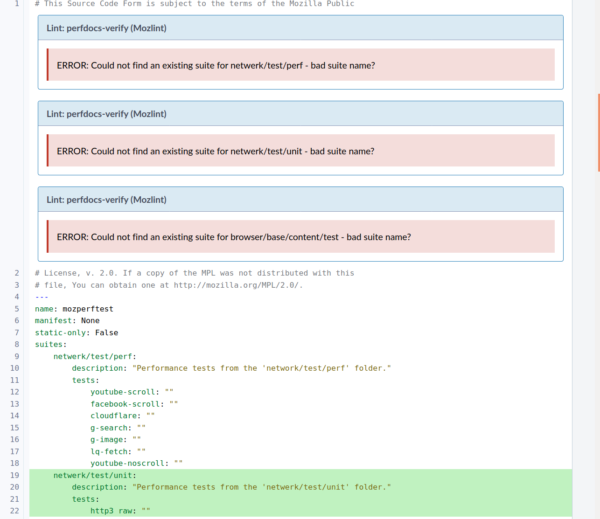
The review-bot left a complaint on this patch which was adding new suites. This one is because we could not find the actual tests.
In the future, we hope to be able to expand this tool and its features from our performance tests to the massive box of functional tests that we have. If you think having 462 metrics to track is a lot, consider the thousands of tests we have for ensuring that Firefox functionality is properly tested.
This project started in Q4 of 2019, with myself [:sparky], and Alexandru Ionescu [:alexandrui] building up the base of this tool. Then, in early H1-2020, Myeongjun Go [:myeongjun], a fantastic volunteer contributor, began hacking on this project and brought us from lightly documenting Raptor tests to having links to the tested pages in it, and even integrating PerfDocs into MozPerftest.
If you have any questions, feel free to reach out to us on Riot in #perftest.
https://blog.mozilla.org/performance/2020/11/03/dynamic-test-documentation-with-perfdocs/
|
|
Daniel Stenberg: HSTS your curl |
HTTP Strict Transport Security (HSTS) is a standard HTTP response header for sites to tell the client that for a specified period of time into the future, that host is not to be accessed with plain HTTP but only using HTTPS. Documented in RFC 6797 from 2012.
The idea is of course to reduce the risk for man-in-the-middle attacks when the server resources might be accessible via both HTTP and HTTPS, perhaps due to legacy or just as an upgrade path. Every access to the HTTP version is then a risk that you get back tampered content.
Browsers preload
These headers have been supported by the popular browsers for years already, and they also have a system setup for preloading a set of sites. Sites that exist in their preload list then never get accessed over HTTP since they know of their HSTS state already when the browser is fired up for the first time.
The entire .dev top-level domain is even in that preload list so you can in fact never access a web site on that top-level domain over HTTP with the major browsers.
With the curl tool
Starting in curl 7.74.0, curl has experimental support for HSTS. Experimental means it isn’t enabled by default and we discourage use of it in production. (Scheduled to be released in December 2020.)
You instruct curl to understand HSTS and to load/save a cache with HSTS information using --hsts . The HSTS cache saved into that file is then updated on exit and if you do repeated invokes with the same cache file, it will effectively avoid clear text HTTP accesses for as long as the HSTS headers tell it.
I envision that users will simply use a small hsts cache file for specific use cases rather than anyone ever really want to have or use a “complete” preload list of domains such as the one the browsers use, as that’s a huge list of sites and for most use cases just completely unnecessary to load and handle.
With libcurl
Possibly, this feature is more useful and appreciated by applications that use libcurl for HTTP(S) transfers. With libcurl the application can set a file name to use for loading and saving the cache but it also gets some added options for more flexibility and powers. Here’s a quick overview:
CURLOPT_HSTS – lets you set a file name to read/write the HSTS cache from/to.
CURLOPT_HSTS_CTRL – enable HSTS functionality for this transfer
CURLOPT_HSTSREADFUNCTION – this callback gets called by libcurl when it is about to start a transfer and lets the application preload HSTS entries – as if they had been read over the wire and been added to the cache.
CURLOPT_HSTSWRITEFUNCTION – this callback gets called repeatedly when libcurl flushes its in-memory cache and allows the application to save the cache somewhere and similar things.
Feedback?
I trust you understand that I’m very very keen on getting feedback on how this works, on the API and your use cases. Both negative and positive. Whatever your thoughts are really!
|
|
Data@Mozilla: This week in Glean: Glean.js |
(“This Week in Glean” is a series of blog posts that the Glean Team at Mozilla is using to try to communicate better about our work. They could be release notes, documentation, hopes, dreams, or whatever: so long as it is inspired by Glean.)
In a previous TWiG blog post, I talked about my experiment on trying to compile glean-core to Wasm. The motivation for that experiment was the then upcoming Glean.js workweek, where some of us were going to take a pass at building a proof-of-concept implementation of Glean in Javascript. That blog post ends on the following note:
My conclusion is that although we can compile glean-core to Wasm, it doesn’t mean that we should do that. The advantages of having a single source of truth for the Glean SDK are very enticing, but at the moment it would be more practical to rewrite something specific for the web.
When I wrote that post, we hadn’t gone through the Glean.js workweek and were not sure yet if it would be viable to pursue a new implementation of Glean in Javascript.
I am not going to keep up the suspense though. We were able to implement a proof of concept version of Glean that works in Javascript environments during that workweek, it:
- Persisted data throughout application runs (e.g. client_id);
- Allowed for recording event metrics;
- Sent Glean schema compliant pings to the pipeline.
And all of this, we were able to make work on:
- Static websites;
- Svelte apps;
- Node.js servers;
- Electron apps;
- Node.js command like applications;
- Node.js server applications;
- Qt/QML apps.
Check out the code for this project on: https://github.com/brizental/gleanjs
The outcome of the workweek confirmed it was possible and worth it to go ahead with Glean.js. For the past weeks the Glean SDK team has officially started working on the roadmap for this project’s MVP.
Our plan is to have an MVP of Glean.js that can be used on webextensions by February/2021.
The reason for our initial focus on webextensions is that the Ion project has volunteered to be Glean.js’ first consumer. Support for static websites and Qt/QML apps will follow. Other consumers such as Node.js servers and CLIs are not part of the initial roadmap.
Although we learned a lot by building the POC, we were probably left with more open questions than answered ones. The Javascript environment is a very special one and when we set out to build something that can work virtually anywhere that runs Javascript, we were embarking on an adventure.
Each Javascript environment has different resources the developer can interact with. Let’s think, for example, about persistence solutions: on web browsers we can use localStorage or IndexedDB, but on Node.js servers / CLIs we would need to go another way completely and use Level DB or some other external library. What is the best way to deal with this and what exactly are the differences between environments?
The issue of having different resources is not even the most challenging one. Glean defines internal metrics and their lifetimes, and internal pings and their schedules. This is important so that our users can do base analysis without having any custom metrics or pings. The hardest open question we were left with was: what pings should Glean.js send out of the box and what should their scheduling look like?
Because Glean.js opens up possibilities for such varied consumers: from websites to CLIs, defining scheduling that will be universal for all of its consumers is probably not even possible. If we decide to tackle these questions for each environment separately, we are still facing tricky consumers and consumers that we are not used to, such as websites and web extensions.
Websites specifically come with many questions: how can we guarantee client side data persistence, if a user can easily delete all of it by running some code in the console or tweaking browser settings. What is the best scheduling for pings, if each website can have so many different usage lifecycles?
We are excited to tackle these and many other challenges in the coming months. Development of the roadmap can be followed on Bug 1670910.
https://blog.mozilla.org/data/2020/11/02/this-week-in-glean-glean-js/
|
|
Dustin J. Mitchell: Taskcluster's DB (Part 2) - DB Migrations |
This is part 2 of a deep-dive into the implementation details of Taskcluster’s backend data stores. Check out part 1 for the background, as we’ll jump right in here!
Azure in Postgres
As of the end of April, we had all of our data in a Postgres database, but the data was pretty ugly. For example, here’s a record of a worker as recorded by worker-manager:
partition_key | testing!2Fstatic-workers
row_key | cc!2Fdd~ee!2Fff
value | {
"state": "requested",
"RowKey": "cc!2Fdd~ee!2Fff",
"created": "2015-12-17T03:24:00.000Z",
"expires": "3020-12-17T03:24:00.000Z",
"capacity": 2,
"workerId": "ee/ff",
"providerId": "updated",
"lastChecked": "2017-12-17T03:24:00.000Z",
"workerGroup": "cc/dd",
"PartitionKey": "testing!2Fstatic-workers",
"lastModified": "2016-12-17T03:24:00.000Z",
"workerPoolId": "testing/static-workers",
"__buf0_providerData": "eyJzdGF0aWMiOiJ0ZXN0ZGF0YSJ9Cg==",
"__bufchunks_providerData": 1
}
version | 1
etag | 0f6e355c-0e7c-4fe5-85e3-e145ac4a4c6c
To reap the goodness of a relational database, that would be a “normal”[] table: distinct columns, nice data types, and a lot less redundancy.
All access to this data is via some Azure-shaped stored functions, which are also not amenable to the kinds of flexible data access we need:
_load _create _remove _modify _scan
[] In the normal sense of the word – we did not attempt to apply database normalization.
Database Migrations
So the next step, which we dubbed “phase 2”, was to migrate this schema to one more appropriate to the structure of the data.
The typical approach is to use database migrations for this kind of work, and there are lots of tools for the purpose. For example, Alembic and Django both provide robust support for database migrations – but they are both in Python.
The only mature JS tool is knex, and after some analysis we determined that it both lacked features we needed and brought a lot of additional features that would complicate our usage. It is primarily a “query builder”, with basic support for migrations. Because we target Postgres directly, and because of how we use stored functions, a query builder is not useful. And the migration support in knex, while effective, does not support the more sophisticated approaches to avoiding downtime outlined below.
We elected to roll our own tool, allowing us to get exactly the behavior we wanted.
Migration Scripts
Taskcluster defines a sequence of numbered database versions. Each version corresponds to a specific database schema, which includes the structure of the database tables as well as stored functions. The YAML file for each version specifies a script to upgrade from the previous version, and a script to downgrade back to that version. For example, an upgrade script might add a new column to a table, with the corresponding downgrade dropping that column.
version: 29
migrationScript: |-
begin
alter table secrets add column last_used timestamptz;
end
downgradeScript: |-
begin
alter table secrets drop column last_used;
end
So far, this is a pretty normal approach to migrations. However, a major drawback is that it requires careful coordination around the timing of the migration and deployment of the corresponding code. Continuing the example of adding a new column, if the migration is deployed first, then the existing code may execute INSERT queries that omit the new column. If the new code is deployed first, then it will attempt to read a column that does not yet exist.
There are workarounds for these issues. In this example, adding a default value for the new column in the migration, or writing the queries such that they are robust to a missing column. Such queries are typically spread around the codebase, though, and it can be difficult to ensure (by testing, of course) that they all operate correctly.
In practice, most uses of database migrations are continuously-deployed applications – a single website or application server, where the developers of the application control the timing of deployments. That allows a great deal of control, and changes can be spread out over several migrations that occur in rapid succession.
Taskcluster is not continuously deployed – it is released in distinct versions which users can deploy on their own cadence. So we need a way to run migrations when upgrading to a new Taskcluster release, without breaking running services.
Stored Functions
Part 1 mentioned that all access to data is via stored functions. This is the critical point of abstraction that allows smooth migrations, because stored functions can be changed at runtime.
Each database version specifies definitions for stored functions, either introducing new functions or replacing the implementation of existing functions.
So the version: 29 YAML above might continue with
methods:
create_secret:
args: name text, value jsonb
returns: ''
body: |-
begin
insert
into secrets (name, value, last_used)
values (name, value, now());
end
get_secret:
args: name text
returns: record
body: |-
begin
update secrets
set last_used = now()
where secrets.name = get_secret.name;
return query
select name, value from secrets
where secrets.name = get_secret.name;
end
This redefines two existing functions to operate properly against the new table.
The functions are redefined in the same database transaction as the migrationScript above, meaning that any calls to create_secret or get_secret will immediately begin populating the new column.
A critical rule (enforced in code) is that the arguments and return type of a function cannot be changed.
To support new code that references the last_used value, we add a new function:
get_secret_with_last_used:
args: name text
returns: record
body: |-
begin
update secrets
set last_used = now()
where secrets.name = get_secret.name;
return query
select name, value, last_used from secrets
where secrets.name = get_secret.name;
end
Another critical rule is that DB migrations must be applied fully before the corresponding version of the JS code is deployed.
In this case, that means code that uses get_secret_with_last_used is deployed only after the function is defined.
All of this can be thoroughly tested in isolation from the rest of the Taskcluster code, both unit tests for the functions and integration tests for the upgrade and downgrade scripts. Unit tests for redefined functions should continue to pass, unchanged, providing an easy-to-verify compatibility check.
Phase 2 Migrations
The migrations from Azure-style tables to normal tables are, as you might guess, a lot more complex than this simple example. Among the issues we faced:
- Azure-entities uses a multi-field base64 encoding for many data-types, that must be decoded (such as
__buf0_providerData/__bufchunks_providerDatain the example above) - Partition and row keys are encoded using a custom variant of urlencoding that is remarkably difficult to implement in pl/pgsql
- Some columns (such as secret values) are encrypted.
- Postgres generates slightly different ISO8601 timestamps from JS’s
Date.toJSON()
We split the work of performing these migrations across the members of the Taskcluster team, supporting each other through the tricky bits, in a rather long but ultimately successful “Postgres Phase 2” sprint.
0042 - secrets phase 2
Let’s look at one of the simpler examples: the secrets service.
The migration script creates a new secrets table from the data in the secrets_entities table, using Postgres’s JSON function to unpack the value column into “normal” columns.
The database version YAML file carefully redefines the Azure-compatible DB functions to access the new secrets table.
This involves unpacking function arguments from their JSON formats, re-packing JSON blobs for return values, and even some light parsing of the condition string for the secrets_entities_scan function.
It then defines new stored functions for direct access to the normal table. These functions are typically similar, and more specific to the needs of the service. For example, the secrets service only modifies secrets in an “upsert” operation that replaces any existing secret of the same name.
Step By Step
To achieve an extra layer of confidence in our work, we landed all of the phase-2 PRs in two steps. The first step included migration and downgrade scripts and the redefined stored functions, as well as tests for those. But critically, this step did not modify the service using the table (the secrets service in this case). So the unit tests for that service use the redefined stored functions, acting as a kind of integration-test for their implementations. This also validates that the service will continue to run in production between the time the database migration is run and the time the new code is deployed. We landed this step on GitHub in such a way that reviewers could see a green check-mark on the step-1 commit.
In the second step, we added the new, purpose-specific stored functions and rewrote the service to use them. In services like secrets, this was a simple change, but some other services saw more substantial rewrites due to more complex requirements.
Deprecation
Naturally, we can’t continue to support old functions indefinitely: eventually they would be prohibitively complex or simply impossible to implement. Another deployment rule provides a critical escape from this trap: Taskcluster must be upgraded at most one major version at a time (e.g., 36.x to 37.x). That provides a limited window of development time during which we must maintain compatibility.
Defining that window is surprisingly tricky, but essentially it’s two major revisions. Like the software engineers we are, we packaged up that tricky computation in a script, and include the lifetimes in some generated documentation
What’s Next?
This post has hinted at some of the complexity of “phase 2”. There are lots of details omitted, of course!
But there’s one major detail that got us in a bit of trouble.
In fact, we were forced to roll back during a planned migration – not an engineer’s happiest moment.
The queue_tasks_entities and queue_artifacts_entities table were just too large to migrate in any reasonable amount of time.
Part 3 will describe what happened, how we fixed the issue, and what we’re doing to avoid having the same issue again.
|
|
Daniel Stenberg: Everything curl in Chinese |
The other day we celebrated everything curl turning 5 years old, and not too long after that I got myself this printed copy of the Chinese translation in my hands!
This version of the book is available for sale on Amazon and the translation was done by the publisher.
The book’s full contents are available on github and you can read the English version online on ec.haxx.se.
If you would be interested in starting a translation of the book into another language, let me know and I’ll help you get started. Currently the English version consists of 72,798 words so it’s by no means an easy feat to translate! My other two other smaller books, http2 explained and HTTP/3 explained have been translated into twelve(!) and ten languages this way (and there might be more languages coming!).


Unfortunately I don’t read Chinese so I can’t tell you how good the translation is!
https://daniel.haxx.se/blog/2020/10/29/everything-curl-in-chinese/
|
|
Mozilla Addons Blog: Contribute to selecting new Recommended extensions |
 Recommended extensions—a curated list of extensions that meet Mozilla’s highest standards of security, functionality, and user experience—are in part selected with input from a rotating editorial board of community contributors. Each board runs for six consecutive months and evaluates a small batch of new Recommended candidates each month. The board’s evaluation plays a critical role in helping identify new potential Recommended additions.
Recommended extensions—a curated list of extensions that meet Mozilla’s highest standards of security, functionality, and user experience—are in part selected with input from a rotating editorial board of community contributors. Each board runs for six consecutive months and evaluates a small batch of new Recommended candidates each month. The board’s evaluation plays a critical role in helping identify new potential Recommended additions.
We are now accepting applications for community board members through 18 November. If you would like to nominate yourself for consideration on the board, please email us at amo-featured [at] mozilla [dot] org and provide a brief explanation why you feel you’d make a keen evaluator of Firefox extensions. We’d love to hear about how you use extensions and what you find so remarkable about browser customization. You don’t have to be an extension developer to effectively evaluate Recommended candidates (though indeed many past board members have been developers themselves), however you should have a strong familiarity with extensions and be comfortable assessing the strengths and flaws of their functionality and user experience.
Selected contributors will participate in a six-month project that runs from December – May.
Here’s the entire collection of Recommended extensions, if curious to explore what’s currently curated.
Thank you and we look forward to hearing from interested contributors by the 18 November application deadline!
The post Contribute to selecting new Recommended extensions appeared first on Mozilla Add-ons Blog.
https://blog.mozilla.org/addons/2020/10/29/contribute-to-selecting-new-recommended-extensions/
|
|
Hacks.Mozilla.Org: MDN Web Docs evolves! Lowdown on the upcoming new platform |
The time has come for Kuma — the platform that powers MDN Web Docs — to evolve. For quite some time now, the MDN developer team has been planning a radical platform change, and we are ready to start sharing the details of it. The question on your lips might be “What does a Kuma evolve into? A KumaMaMa?”

For those of you not so into Pok'emon, the question might instead be “How exactly is MDN changing, and how does it affect MDN users and contributors”?
For general users, the answer is easy — there will be very little change to how we serve the great content you use everyday to learn and do your jobs.
For contributors, the answer is a bit more complex.
The changes in a nutshell
In short, we are updating the platform to move the content from a MySQL database to being hosted in a GitHub repository (codename: Project Yari).

The main advantages of this approach are:
- Less developer maintenance burden: The existing (Kuma) platform is complex and hard to maintain. Adding new features is very difficult. The update will vastly simplify the platform code — we estimate that we can remove a significant chunk of the existing codebase, meaning easier maintenance and contributions.
- Better contribution workflow: We will be using GitHub’s contribution tools and features, essentially moving MDN from a Wiki model to a pull request (PR) model. This is so much better for contribution, allowing for intelligent linting, mass edits, and inclusion of MDN docs in whatever workflows you want to add it to (you can edit MDN source files directly in your favorite code editor).
- Better community building: At the moment, MDN content edits are published instantly, and then reverted if they are not suitable. This is really bad for community relations. With a PR model, we can review edits and provide feedback, actually having conversations with contributors, building relationships with them, and helping them learn.
- Improved front-end architecture: The existing MDN platform has a number of front-end inconsistencies and accessibility issues, which we’ve wanted to tackle for some time. The move to a new, simplified platform gives us a perfect opportunity to fix such issues.
The exact form of the platform is yet to be finalized, and we want to involve you, the community, in helping to provide ideas and test the new contribution workflow! We will have a beta version of the new platform ready for testing on November 2, and the first release will happen on December 14.
Simplified back-end platform
We are replacing the current MDN Wiki platform with a JAMStack approach, which publishes the content managed in a GitHub repo. This has a number of advantages over the existing Wiki platform, and is something we’ve been considering for a number of years.
Before we discuss our new approach, let’s review the Wiki model so we can better understand the changes we’re making.
Current MDN Wiki platform
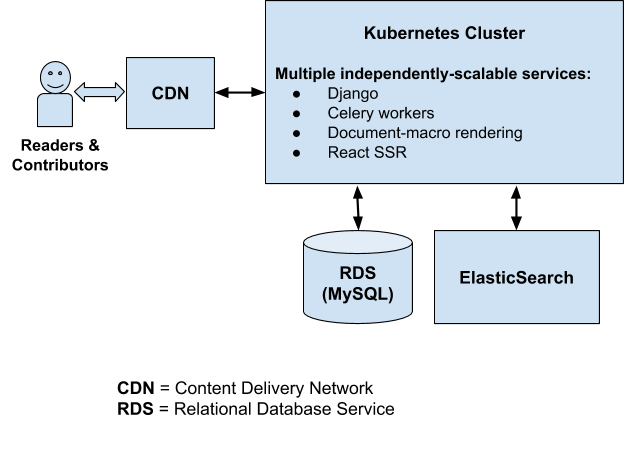
It’s important to note that both content contributors (writers) and content viewers (readers) are served via the same architecture. That architecture has to accommodate both use cases, even though more than 99% of our traffic comprises document page requests from readers. Currently, when a document page is requested, the latest version of the document is read from our MySQL database, rendered into its final HTML form, and returned to the user via the CDN.
That document page is stored and served from the CDN’s cache for the next 5 minutes, so subsequent requests — as long as they’re within that 5-minute window — will be served directly by the CDN. That caching period of 5 minutes is kept deliberately short, mainly due to the fact that we need to accommodate the needs of the writers. If we only had to accommodate the needs of the readers, we could significantly increase the caching period and serve our document pages more quickly, while at the same time reducing the workload on our backend servers.
You’ll also notice that because MDN is a Wiki platform, we’re responsible for managing all of the content, and tasks like storing document revisions, displaying the revision history of a document, displaying differences between revisions, and so on. Currently, the MDN development team maintains a large chunk of code devoted to just these kinds of tasks.
New MDN platform
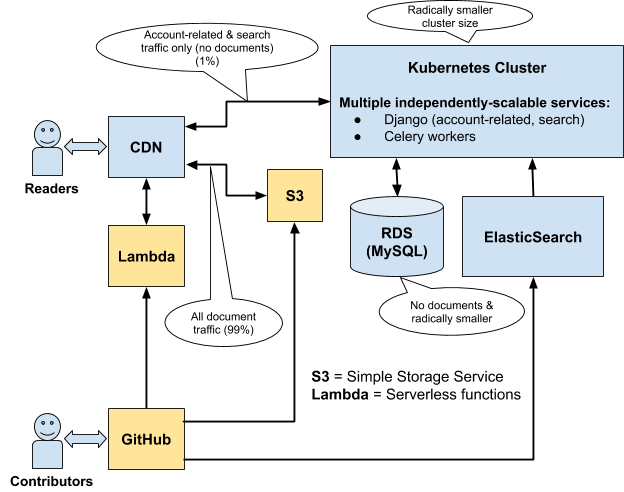
With the new JAMStack approach, the writers are served separately from the readers. The writers manage the document content via a GitHub repository and pull request model, while the readers are served document pages more quickly and efficiently via pre-rendered document pages served from S3 via a CDN (which will have a much longer caching period). The document content from our GitHub repository will be rendered and deployed to S3 on a daily basis.
You’ll notice, from the diagram above, that even with this new approach, we still have a Kubernetes cluster with Django-based services relying on a relational database. The important thing to remember is that this part of the system is no longer involved with the document content. Its scope has been dramatically reduced, and it now exists solely to provide APIs related to user accounts (e.g. login) and search.
This separation of concerns has multiple benefits, the most important three of which are as follows:
- First, the document pages are served to readers in the simplest, quickest, and most efficient way possible. That’s really important, because 99% of MDN’s traffic is for readers, and worldwide performance is fundamental to the user experience.
- Second, because we’re using GitHub to manage our document content, we can take advantage of the world-class functionality that GitHub has to offer as a content management system, and we no longer have to support the large body of code related to our current Wiki platform. It can simply be deleted.
- Third, and maybe less obvious, is that this new approach brings more power to the platform. We can, for example, perform automated linting and testing on each content pull request, which allows us to better control quality and security.
New contribution workflow
Because MDN content is soon to be contained in a GitHub repo, the contribution workflow will change significantly. You will no longer be able to click Edit on a page, make and save a change, and have it show up nearly immediately on the page. You’ll also no longer be able to do your edits in a WYSIWYG editor.
Instead, you’ll need to use git/GitHub tooling to make changes, submit pull requests, then wait for changes to be merged, the new build to be deployed, etc. For very simple changes such as fixing typos or adding new paragraphs, this may seem like a step back — Kuma is certainly convenient for such edits, and for non-developer contributors.
However, making a simple change is arguably no more complex with Yari. You can use the GitHub UI’s edit feature to directly edit a source file and then submit a PR, meaning that you don’t have to be a git genius to contribute simple fixes.
For more complex changes, you’ll need to use the git CLI tool, or a GUI tool like GitHub Desktop, but then again git is such a ubiquitous tool in the web industry that it is safe to say that if you are interested in editing MDN, you will probably need to know git to some degree for your career or course. You could use this as a good opportunity to learn git if you don’t know it already! On top of that there is a file system structure to learn, and some new tools/commands to get used to, but nothing terribly complex.
Another possible challenge to mention is that you won’t have a WYSIWYG to instantly see what the page looks like as you add your content, and in addition you’ll be editing raw HTML, at least initially (we are talking about converting the content to markdown eventually, but that is a bit of a ways off). Again, this sounds like a step backwards, but we are providing a tool inside the repo so that you can locally build and preview the finished page to make sure it looks right before you submit your pull request.
Looking at the advantages now, consider that making MDN content available as a GitHub repo is a very powerful thing. We no longer have spam content live on the site, with us then having to revert the changes after the fact. You are also free to edit MDN content in whatever way suits you best — your favorite IDE or code editor — and you can add MDN documentation into your preferred toolchain (and write your own tools to edit your MDN editing experience). A lot of engineers have told us in the past that they’d be much happier to contribute to MDN documentation if they were able to submit pull requests, and not have to use a WYSIWYG!
We are also looking into a powerful toolset that will allow us to enhance the reviewing process, for example as part of a CI process — automatically detecting and closing spam PRs, and as mentioned earlier on, linting pages once they’ve been edited, and delivering feedback to editors.
Having MDN in a GitHub repo also offers much easier mass edits; blanket content changes have previously been very difficult.
Finally, the “time to live” should be acceptable — we are aiming to have a quick turnaround on the reviews, and the deployment process will be repeated every 24 hours. We think that your changes should be live on the site in 48 hours as a worst case scenario.
Better community building
Currently MDN is not a very lively place in terms of its community. We have a fairly active learning forum where people ask beginner coding questions and seek help with assessments, but there is not really an active place where MDN staff and volunteers get together regularly to discuss documentation needs and contributions.
Part of this is down to our contribution model. When you edit an MDN page, either your contribution is accepted and you don’t hear anything, or your contribution is reverted and you … don’t hear anything. You’ll only know either way by looking to see if your edit sticks, is counter-edited, or is reverted.
This doesn’t strike us as very friendly, and I think you’ll probably agree. When we move to a git PR model, the MDN community will be able to provide hands-on assistance in helping people to get their contributions right — offering assistance as we review their PRs (and offering automated help too, as mentioned previously) — and also thanking people for their help.
It’ll also be much easier for contributors to show how many contributions they’ve made, and we’ll be adding in-page links to allow people to file an issue on a specific page or even go straight to the source on GitHub and fix it themselves, if a problem is encountered.
In terms of finding a good place to chat about MDN content, you can join the discussion on the MDN Web Docs chat room on Matrix.
Improved front-end architecture
The old Kuma architecture has a number of front-end issues. Historically we have lacked a well-defined system that clearly describes the constraints we need to work within, and what our site features look like, and this has led to us ending up with a bloated, difficult to maintain front-end code base. Working on our current HTML and CSS is like being on a roller coaster with no guard-rails.
To be clear, this is not the fault of any one person, or any specific period in the life of the MDN project. There are many little things that have been left to fester, multiply, and rot over time.
Among the most significant problems are:
- Accessibility: There are a number of accessibility problems with the existing architecture that really should be sorted out, but were difficult to get a handle on because of Kuma’s complexity.
- Component inconsistency: Kuma doesn’t use a proper design system — similar items are implemented in different ways across the site, so implementing features is more difficult than it needs to be.
When we started to move forward with the back-end platform rewrite, it felt like the perfect time to again propose the idea of a design system. After many conversations leading to an acceptable compromise being reached, our design system — MDN Fiori — was born.
Front-end developer Schalk Neethling and UX designer Mustafa Al-Qinneh took a whirlwind tour through the core of MDN’s reference docs to identify components and document all the inconsistencies we are dealing with. As part of this work, we also looked for areas where we can improve the user experience, and introduce consistency through making small changes to some core underlying aspects of the overall design.
This included a defined color palette, simple, clean typography based on a well-defined type scale, consistent spacing, improved support for mobile and tablet devices, and many other small tweaks. This was never meant to be a redesign of MDN, so we had to be careful not to change too much. Instead, we played to our existing strengths and made rogue styles and markup consistent with the overall project.
Besides the visual consistency and general user experience aspects, our underlying codebase needed some serious love and attention — we decided on a complete rethink. Early on in the process it became clear that we needed a base library that was small, nimble, and minimal. Something uniquely MDN, but that could be reused wherever the core aspects of the MDN brand was needed. For this purpose we created MDN-Minimalist, a small set of core atoms that power the base styling of MDN, in a progressively enhanced manner, taking advantage of the beautiful new layout systems we have access to on the web today.
Each component that is built into Yari is styled with MDN-Minimalist, and also has its own style sheet that lives right alongside to apply further styles only when needed. This is an evolving process as we constantly rethink how to provide a great user experience while staying as close to the web platform as possible. The reason for this is two fold:
- First, it means less code. It means less reinventing of the wheel. It means a faster, leaner, less bandwidth-hungry MDN for our end users.
- Second, it helps address some of the accessibility issues we have begrudgingly been living with for some time, which are simply not acceptable on a modern web site. One of Mozilla’s accessibility experts, Marco Zehe, has given us a lot of input to help overcome these. We won’t fix everything in our first iteration, but our pledge to all of our users is that we will keep improving and we welcome your feedback on areas where we can improve further.
A wise person once said that the best way to ensure something is done right is to make doing the right thing the easy thing to do. As such, along with all of the work already mentioned, we are documenting our front-end codebase, design system, and pattern library in Storybook (see Storybook files inside the yari repo) with companion design work in Figma (see typography example) to ensure there is an easy, public reference for anyone who wishes to contribute to MDN from a code or design perspective. This in itself is a large project that will evolve over time. More communication about its evolution will follow.
The future of MDN localization
One important part of MDN’s content that we have talked about a lot during the planning phase is the localized content. As you probably already know, MDN offers facilities for translating the original English content and making the localizations available alongside it.
This is good in principle, but the current system has many flaws. When an English page is moved, the localizations all have to be moved separately, so pages and their localizations quite often go out of sync and get in a mess. And a bigger problem is that there is no easy way of signalling that the English version has changed to all the localizers.
General management is probably the most significant problem. You often get a wave of enthusiasm for a locale, and lots of translations done. But then after a number of months interest wanes, and no-one is left to keep the translations up to date. The localized content becomes outdated, which is often harmful to learning, becomes a maintenance time-suck, and as a result, is often considered worse than having no localizations at all.
Note that we are not saying this is true of all locales on MDN, and we are not trying to downplay the amount of work volunteers have put into creating localized content. For that, we are eternally grateful. But the fact remains that we can’t carry on like this.
We did a bunch of research, and talked to a lot of non-native-English speaking web developers about what would be useful to them. Two interesting conclusions were made:
- We stand to experience a significant but manageable loss of users if we remove or reduce our localization support. 8 languages cover 90% of the accept-language headers received from MDN users (en, zh, es, ja, fr, ru, pt, de), while 14 languages cover 95% of the accept-languages. We predict that we would expect to lose at most 19% of our traffic if we dropped L10n entirely.
- Machine translations are an acceptable solution in most cases, if not a perfect one. We looked at the quality of translations provided by automated solutions such as Google Translate and got some community members to compare these translations to manual translations. The machine translations were imperfect, and sometimes hard to understand, but many people commented that a non-perfect language that is up-to-date is better than a perfect language that is out-of-date. We appreciate that some languages (such as CJK languages) fare less well than others with automated translations.
So what did we decide? With the initial release of the new platform, we are planning to include all translations of all of the current documents, but in a frozen state. Translations will exist in their own mdn/translated-content repository, to which we will not accept any pull requests. The translations will be shown with a special header that says “This is an archived translation. No more edits are being accepted.” This is a temporary stage until we figure out the next step.
Note: In addition, the text of the UI components and header menu will be in English only, going forward. They will not be translated, at least not initially.
After the initial release, we want to work with you, the community, to figure out the best course of action to move forward with for translations. We would ideally rather not lose localized content on MDN, but we need to fix the technical problems of the past, manage it better, and ensure that the content stays up-to-date.
We will be planning the next phase of MDN localization with the following guiding principles:
- We should never have outdated localized content on MDN.
- Manually localizing all MDN content in a huge range of locales seems infeasible, so we should drop that approach.
- Losing ~20% of traffic is something we should avoid, if possible.
We are making no promises about deliverables or time frames yet, but we have started to think along these lines:
- Cut down the number of locales we are handling to the top 14 locales that give us 95% of our recorded accept-language headers.
- Initially include non-editable Machine Learning-based automated translations of the “tier-1” MDN content pages (i.e. a set of the most important MDN content that excludes the vast long tail of articles that get no, or nearly no views). Ideally we’d like to use the existing manual translations to train the Machine Learning system, hopefully getting better results. This is likely to be the first thing we’ll work on in 2021.
- Regularly update the automated translations as the English content changes, keeping them up-to-date.
- Start to offer a system whereby we allow community members to improve the automated translations with manual edits. This would require the community to ensure that articles are kept up-to-date with the English versions as they are updated.
Sign up for the beta test
As we mentioned earlier, we are going to launch a beta test of the new MDN platform on November 2nd. We would love your help in testing out the new system and contribution workflow, letting us know what aspects seem good and what aspects seem painful, and suggesting improvements.
If you want to be notified when the new system is ready for testing, please let us know using this form.
Acknowledgements
I’d like to thank my colleagues Schalk Neethling, Ryan Johnson, Peter Bengtsson, Rina Tambo Jensen, Hermina Condei, Melissa Thermidor, and anyone else I’ve forgotten who helped me polish this article with bits of content, feedback, reviews, edits, and more.
The post MDN Web Docs evolves! Lowdown on the upcoming new platform appeared first on Mozilla Hacks - the Web developer blog.
https://hacks.mozilla.org/2020/10/mdn-web-docs-evolves-lowdown-on-the-upcoming-new-platform/
|
|
Dustin J. Mitchell: Taskcluster's DB (Part 1) - Azure to Postgres |
This is a deep-dive into some of the implementation details of Taskcluster. Taskcluster is a platform for building continuous integration, continuous deployment, and software-release processes. It’s an open source project that began life at Mozilla, supporting the Firefox build, test, and release systems.
The Taskcluster “services” are a collection of microservices that handle distinct tasks: the queue coordinates tasks; the worker-manager creates and manages workers to execute tasks; the auth service authenticates API requests; and so on.
Azure Storage Tables to Postgres
Until April 2020, Taskcluster stored its data in Azure Storage tables, a simple NoSQL-style service similar to AWS’s DynamoDB. Briefly, each Azure table is a list of JSON objects with a single primary key composed of a partition key and a row key. Lookups by primary key are fast and parallelize well, but scans of an entire table are extremely slow and subject to API rate limits. Taskcluster was carefully designed within these constraints, but that meant that some useful operations, such as listing tasks by their task queue ID, were simply not supported. Switching to a fully-relational datastore would enable such operations, while easing deployment of the system for organizations that do not use Azure.
Always Be Migratin’
In April, we migrated the existing deployments of Taskcluster (at that time all within Mozilla) to Postgres. This was a “forklift migration”, in the sense that we moved the data directly into Postgres with minimal modification. Each Azure Storage table was imported into a single Postgres table of the same name, with a fixed structure:
create table queue_tasks_entities(
partition_key text,
row_key text,
value jsonb not null,
version integer not null,
etag uuid default public.gen_random_uuid()
);
alter table queue_tasks_entities add primary key (partition_key, row_key);
The importer we used was specially tuned to accomplish this import in a reasonable amount of time (hours). For each known deployment, we scheduled a downtime to perform this migration, after extensive performance testing on development copies.
We considered options to support a downtime-free migration. For example, we could have built an adapter that would read from Postgres and Azure, but write to Postgres. This adapter could support production use of the service while a background process copied data from Azure to Postgres.
This option would have been very complex, especially in supporting some of the atomicity and ordering guarantees that the Taskcluster API relies on. Failures would likely lead to data corruption and a downtime much longer than the simpler, planned downtime. So, we opted for the simpler, planned migration. (we’ll revisit the idea of online migrations in part 3)
The database for Firefox CI occupied about 350GB. The other deployments, such as the community deployment, were much smaller.
Database Interface
All access to Azure Storage tables had been via the azure-entities library, with a limited and very regular interface (hence the _entities suffix on the Postgres table name).
We wrote an implementation of the same interface, but with a Postgres backend, in taskcluster-lib-entities.
The result was that none of the code in the Taskcluster microservices changed.
Not changing code is a great way to avoid introducing new bugs!
It also limited the complexity of this change: we only had to deeply understand the semantics of azure-entities, and not the details of how the queue service handles tasks.
Stored Functions
As the taskcluster-lib-entities README indicates, access to each table is via five stored database functions:
_load _create _remove _modify _scan
Stored functions are functions defined in the database itself, that can be redefined within a transaction. Part 2 will get into why we made this choice.
Optimistic Concurrency
The modify function is an interesting case.
Azure Storage has no notion of a “transaction”, so the azure-entities library uses an optimistic-concurrency approach to implement atomic updates to rows.
This uses the etag column, which changes to a new value on every update, to detect and retry concurrent modifications.
While Postgres can do much better, we replicated this behavior in taskcluster-lib-entities, again to limit the changes made and avoid introducing new bugs.
A modification looks like this in Javascript:
await task.modify(task => {
if (task.status !== 'running') {
task.status = 'running';
task.started = now();
}
});
For those not familiar with JS notation, this is calling the modify method on a task, passing a modifier function which, given a task, modifies that task.
The modify method calls the modifier and tries to write the updated row to the database, conditioned on the etag still having the value it did when the task was loaded.
If the etag does not match, modify re-loads the row to get the new etag, and tries again until it succeeds.
The effect is that updates to the row occur one-at-a-time.
This approach is “optimistic” in the sense that it assumes no conflicts, and does extra work (retrying the modification) only in the unusual case that a conflict occurs.
What’s Next?
At this point, we had fork-lifted Azure tables into Postgres and no longer require an Azure account to run Taskcluster. However, we hadn’t yet seen any of the benefits of a relational database:
- data fields were still trapped in a JSON object (in fact, some kinds of data were hidden in base64-encoded blobs)
- each table still only had a single primary key, and queries by any other field would still be prohibitively slow
- joins between tables would also be prohibitively slow
Part 2 of this series of articles will describe how we addressed these issues. Then part 3 will get into the details of performing large-scale database migrations without downtime.
|
|
Mozilla Addons Blog: Extensions in Firefox 83 |
In addition to our brief update on extensions in Firefox 83, this post contains information about changes to the Firefox release calendar and a feature preview for Firefox 84.
Thanks to a contribution from Richa Sharma, the error message logged when a tabs.sendMessage is passed an invalid tabID is now much easier to understand. It had regressed to a generic message due to a previous refactoring.
End of Year Release Calendar
The end of 2020 is approaching (yay?), and as usual people will be taking time off and will be less available. To account for this, the Firefox Release Calendar has been updated to extend the Firefox 85 release cycle by 2 weeks. We will release Firefox 84 on 15 December and Firefox 85 on 26 January. The regular 4-week release cadence should resume after that.
Coming soon in Firefox 84: Manage Optional Permissions in Add-ons Manager
Starting with Firefox 84, currently available on the Nightly pre-release channel, users will be able to manage optional permissions of installed extensions from the Firefox Add-ons Manager (about:addons).
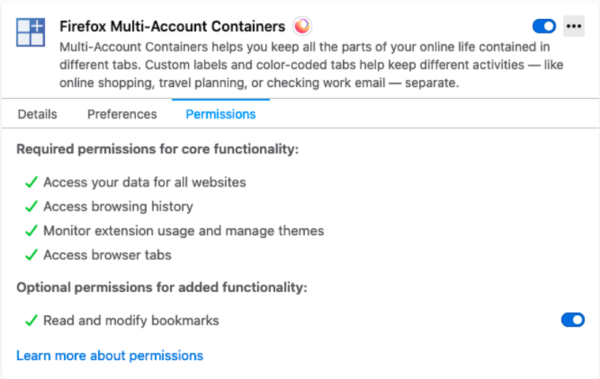
We recommend that extensions using optional permissions listen for the browser.permissions.onAdded and browser.permissions.onRemoved API events. This ensures the extension is aware of the user granting or revoking optional permissions.
The post Extensions in Firefox 83 appeared first on Mozilla Add-ons Blog.
https://blog.mozilla.org/addons/2020/10/28/extensions-in-firefox-83/
|
|
Will Kahn-Greene: Everett v1.0.3 released! |
What is it?
Everett is a configuration library for Python apps.
Goals of Everett:
flexible configuration from multiple configured environments
easy testing with configuration
easy documentation of configuration for users
From that, Everett has the following features:
is composeable and flexible
makes it easier to provide helpful error messages for users trying to configure your software
supports auto-documentation of configuration with a Sphinx
autocomponentdirectivehas an API for testing configuration variations in your tests
can pull configuration from a variety of specified sources (environment, INI files, YAML files, dict, write-your-own)
supports parsing values (bool, int, lists of things, classes, write-your-own)
supports key namespaces
supports component architectures
works with whatever you're writing--command line tools, web sites, system daemons, etc
v1.0.3 released!
This is a minor maintenance update that fixes a couple of minor bugs, addresses a Sphinx deprecation issue, drops support for Python 3.4 and 3.5, and adds support for Python 3.8 and 3.9 (largely adding those environments to the test suite).
Why you should take a look at Everett
At Mozilla, I'm using Everett for a variety of projects: Mozilla symbols server, Mozilla crash ingestion pipeline, and some other tooling. We use it in a bunch of other places at Mozilla, too.
Everett makes it easy to:
deal with different configurations between local development and server environments
test different configuration values
document configuration options
First-class docs. First-class configuration error help. First-class testing. This is why I created Everett.
If this sounds useful to you, take it for a spin. It's a drop-in replacement
for python-decouple and os.environ.get('CONFIGVAR', 'default_value') style
of configuration so it's easy to test out.
Enjoy!
Where to go for more
For more specifics on this release, see here: https://everett.readthedocs.io/en/latest/history.html#october-28th-2020
Documentation and quickstart here: https://everett.readthedocs.io/
Source code and issue tracker here: https://github.com/willkg/everett
|
|
Wladimir Palant: What would you risk for free Honey? |
Honey is a popular browser extension built by the PayPal subsidiary Honey Science LLC. It promises nothing less than preventing you from wasting money on your online purchases. Whenever possible, it will automatically apply promo codes to your shopping cart, thus saving your money without you lifting a finger. And it even runs a reward program that will give you some money back! Sounds great, what’s the catch?
With such offers, the price you pay is usually your privacy. With Honey, it’s also security. The browser extension is highly reliant on instructions it receives from its server. I found at least four ways for this server to run arbitrary code on any website you visit. So the extension can mutate into spyware or malware at any time, for all users or only for a subset of them – without leaving any traces of the attack like a malicious extension release.
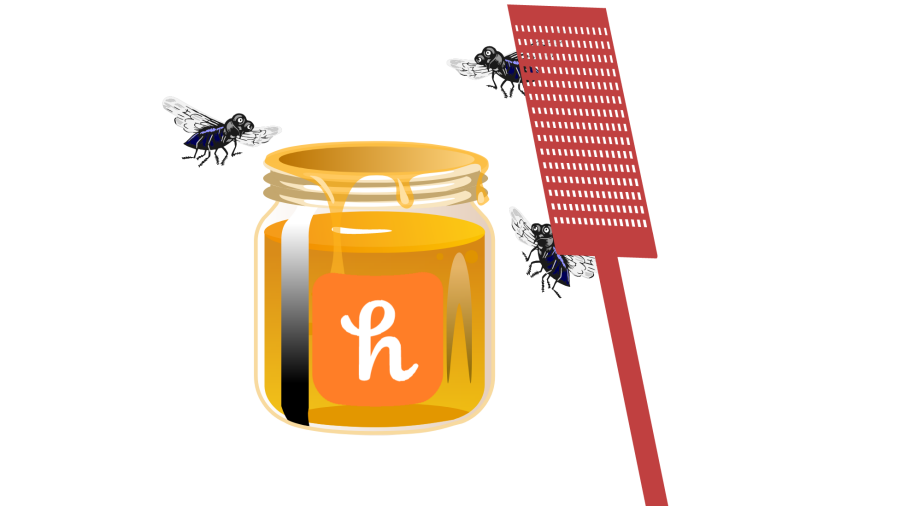
Contents
The trouble with shopping assistants
Please note that there are objective reasons why it’s really hard to build a good shopping assistant. The main issue is how many online shops there are. Honey supports close to 50 thousand shops, yet I easily found a bunch of shops that were missing. Even the shops based on the same engine are typically customized and might have subtle differences in their behavior. Not just that, they will also change without an advance warning. Supporting this zoo is far from trivial.
Add to this the fact that with most of these shops there is very little money to be earned. A shopping assistant needs to work well with Amazon and Shopify. But supporting everything else has to come at close to no cost whatsoever.
The resulting design choices are the perfect recipe for a privacy nightmare:
- As much server-side configuration as somehow possible, to avoid releasing new extension versions unnecessarily
- As much data extraction as somehow possible, to avoid manual monitoring of shop changes
- Bad code quality with many inconsistent approaches, because improving code is costly
I looked into Honey primarily due to its popularity, it being used by more than 17 million users according to the statement on the product’s website. Given the above, I didn’t expect great privacy choices. And while I haven’t seen anything indicating malice, the poor choices made still managed to exceed my expectations by far.
Unique user identifiers
By now you are probably used to reading statements like the following in company’s privacy statements:
None of the information that we collect from these events contains any personally identifiable information (PII) such as names or email addresses.
But of course a persistent semi-random user identifier doesn’t count as “personally identifiable information.” So Honey creates several of those and sends them with every request to its servers:

Here you see the exv value in the Cookie header: it is a combination of the extension version, a user ID (bound to the Honey account if any) and a device ID (locally generated random value, stored persistently in the extension data). The same value is also sent with the payload of various requests.
If you are logged into your Honey account, there will also be x-honey-auth-at and x-honey-auth-rt headers. These are an access and a refresh token respectively. It’s not that these are required (the server will produce the same responses regardless) but they once again associate your requests with your Honey account.
So that’s where this Honey privacy statement is clearly wrong: while the data collected doesn’t contain your email address, Honey makes sure to associate it with your account among other things. And the account is tied to your email address. If you were careless enough to enter your name, there will be a name associated with the data as well.
Remote configure everything
Out of the box, the extension won’t know what to do. Before it can do anything at all, it first needs to ask the server which domains it is supposed to be active on. The result is currently a huge list with some of the most popular domains like google.com, bing.com or microsoft.com listed.
Clearly, not all of google.com is an online shop. So when you visit one of the “supported” domains for the first time within a browsing session, the extension will request additional information:
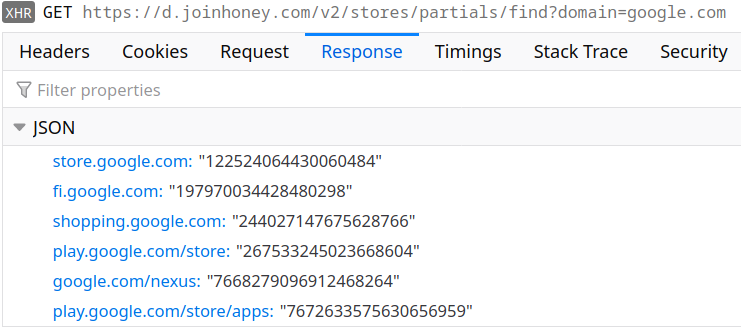
Now the extension knows to ignore all of google.com but the shops listed here. It still doesn’t know anything about the shops however, so when you visit Google Play for example there will be one more request:
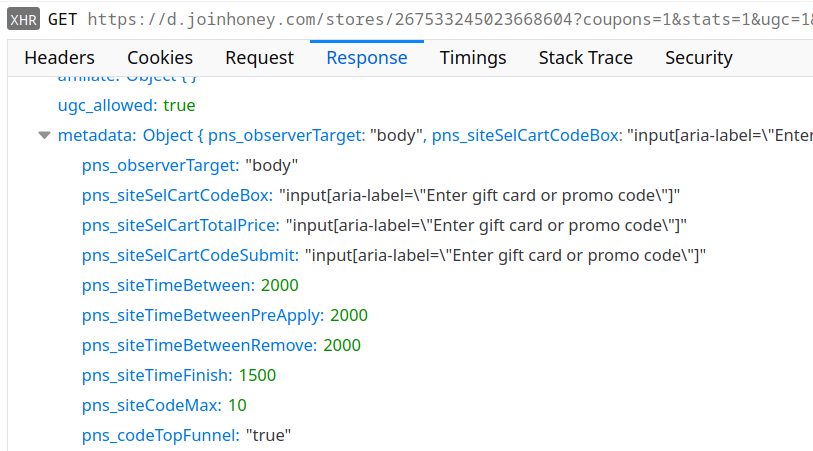
The metadata part of the response is most interesting as it determines much of the extension’s behavior on the respective website. For example, there are optional fields pns_siteSelSubId1 to pns_siteSelSubId3 that determine what information the extension sends back to the server later:
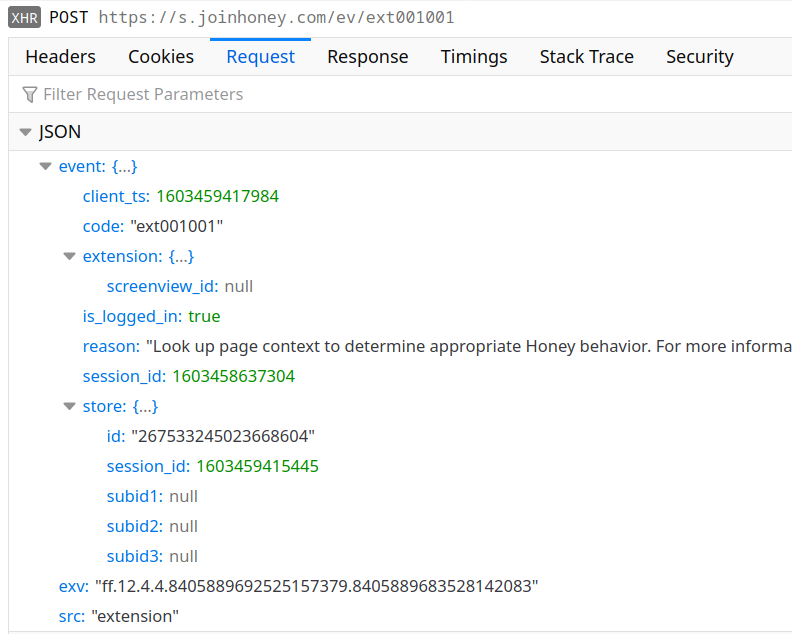
Here the field subid1 and similar are empty because pns_siteSelSubId1 is missing in the store configuration. Were it present, Honey would use it as a CSS selector to find a page element, extract its text and send that text back to the server. Good if somebody wants to know what exactly people are looking at.
Mind you, I only found this functionality enabled on amazon.com and macys.com, yet the selectors provided appear to be outdated and do not match anything. So is this some outdated functionality that is no longer in use and that nobody bothered removing yet? Very likely. Yet it could jump to life any time to collect more detailed information about your browsing habits.
The highly flexible promo code applying process
As you can imagine, the process of applying promo codes can vary wildly between different shops. Yet Honey needs to do it somehow without bothering the user. So while store configuration normally tends to stick to CSS selectors, for this task it will resort to JavaScript code. For example, you get the following configuration for hostgator.com:
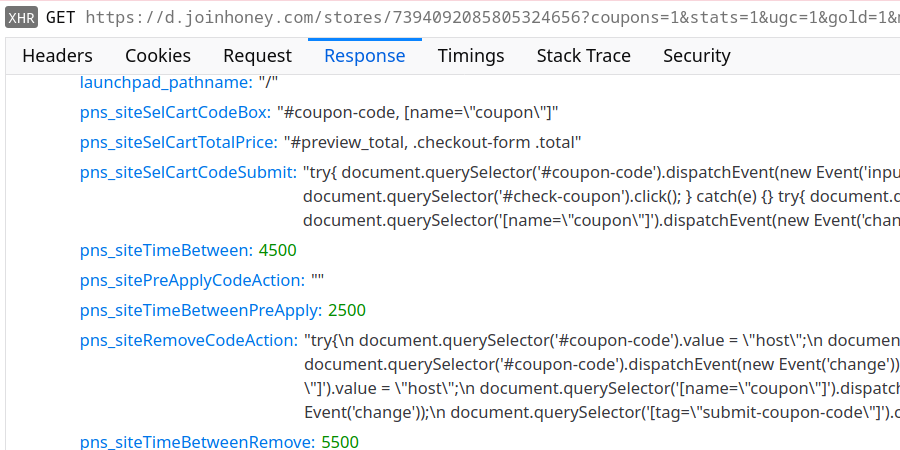
The JavaScript code listed under pns_siteRemoveCodeAction or pns_siteSelCartCodeSubmit will be injected into the web page, so it could do anything there: add more items to the cart, change the shipping address or steal your credit card data. Honey requires us to put lots of trust into their web server, isn’t there a better way?
Turns out, Honey actually found one. Allow me to introduce a mechanism labeled as “DAC” internally for reasons I wasn’t yet able to understand:
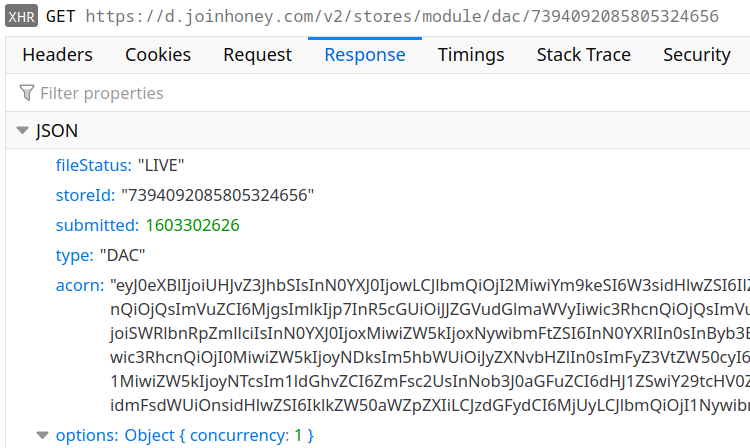
The acorn field here contains base64-encoded JSON data. It’s the output of the acorn JavaScript parser: an Abstract Syntax Tree (AST) of some JavaScript code. When reassembled, it turns into this script:
let price = state.startPrice;
try {
$('#coupon-code').val(code);
$('#check-coupon').click();
setTimeout(3000);
price = $('#preview_total').text();
} catch (_) {
}
resolve({ price });
But Honey doesn’t reassemble the script. Instead, it runs it via a JavaScript-based JavaScript interpreter. This library is explicitly meant to run untrusted code in a sandboxed environment. All one has to do is making sure that the script only gets access to safe functionality.
But you are wondering what this $() function is, aren’t you? It almost looks like jQuery, a library that I called out as a security hazard on multiple occasions. And indeed: Honey chose to expose full jQuery functionality to the sandboxed scripts, thus rendering the sandbox completely useless.
Why did they even bother with this complicated approach? Beats me. I can only imagine that they had trouble with shops using Content Security Policy (CSP) in a way that prohibited execution of arbitrary scripts. So they decided to run the scripts outside the browser where CSP couldn’t stop them.
When selectors aren’t actually selectors
So if the Honey server turned malicious, it would have to enable Honey functionality on the target website, then trick the user into clicking the button to apply promo codes? It could even make that attack more likely to succeed because some of the CSS code styling the button is conveniently served remotely, so the button could be made transparent and spanning the entire page – the user would be bound to click it.
No, that’s still too complicated. Those selectors in the store configuration, what do you think: how are these turned into actual elements? Are you saying document.querySelector()? No, guess again. Is anybody saying “jQuery”? Yes, of course it is using jQuery for extension code as well! And that means that every selector could be potentially booby-trapped.
In the store configuration pictured above, pns_siteSelCartCodeBox field has the selector #coupon-code, [name="coupon"] as its value. What if the server replaces the selector by

This message actually appears multiple times because Honey will evaluate this selector a number of times for each page. It does that for any page of a supported store, unconditionally. Remember that whether a site is a supported store or not is determined by the Honey server. So this is a very simple and reliable way for this server to leverage its privileged access to the Honey extension and run arbitrary code on any website (Universal XSS vulnerability).
How about some obfuscation?
Now we have simple and reliable, but isn’t it also too obvious? What if somebody monitors the extension’s network requests? Won’t they notice the odd JavaScript code?
That scenario is rather unlikely actually, e.g. if you look at how long Avast has been spying on their users with barely anybody noticing. But Honey developers are always up to a challenge. And their solution was aptly named “VIM” (no, they definitely don’t mean the editor). Here is one of the requests downloading VIM code for a store:
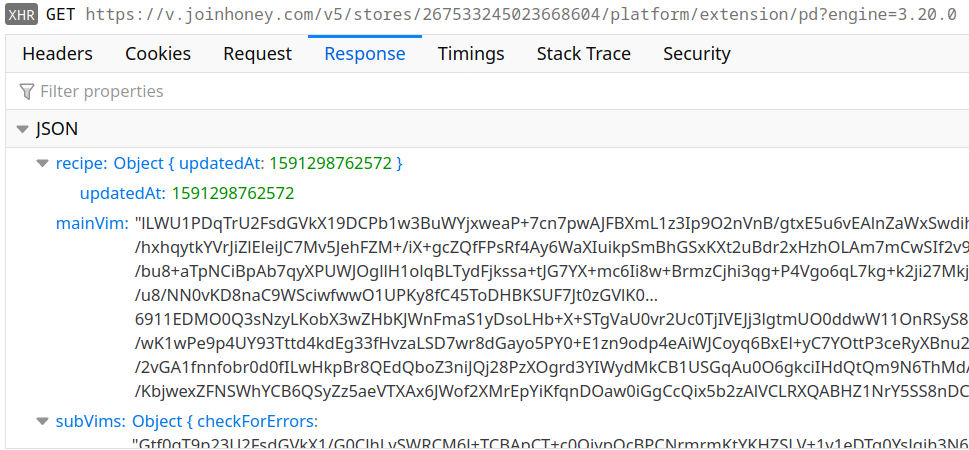
This time, there is no point decoding the base64-encoded data: the result will be binary garbage. As it turns out, the data here has been encrypted using AES, with the start of the string serving as the key. But even after decrypting you won’t be any wiser: the resulting JSON data has all key names replaced by numeric indices and values are once again encrypted.
You need the following script to decrypt the data (requires CryptoJS):
const keys = [
"alternate", "argument", "arguments", "block", "body", "callee", "cases",
"computed", "consequent", "constructor", "declaration", "declarations",
"discriminant", "elements", "expression", "expressions", "finalizer",
"handler", "id", "init", "key", "kind", "label", "left", "method", "name",
"object", "operator", "param", "params", "prefix", "properties", "property",
"quasi", "right", "shorthand", "source", "specifiers", "superClass", "tag",
"test", "type", "update", "value"
];
function decryptValue(obj)
{
if (Array.isArray(obj))
return obj.map(decryptValue);
if (typeof obj != "object" || !obj)
return obj;
let result = {};
for (let key of Object.keys(obj))
{
let value = obj[key];
if (key.startsWith("_"))
key = keys[parseInt(key.substr(1), 10)];
if (typeof value == "string")
value = CryptoJS.AES.decrypt(value.slice(1), value[0] + "+" + key).toString(CryptoJS.enc.Utf8);
else
value = decryptValue(value);
result[key] = value;
}
return result;
}
var data = "" ;
data = JSON.parse(CryptoJS.AES.decrypt(data.slice(10), data.slice(0, 10)).toString(CryptoJS.enc.Utf8));
console.log(decryptValue(data));
What you get is once again the Abstract Syntax Tree (AST) of some JavaScript code. The lengthy chunks of JavaScript code are for example categorizing the pages of a shop, determining what kind of logic should apply to these. And the sandboxing is once again ineffective, with the code being provided access to jQuery for example.
So here is a mechanism, providing the server with a simple way to run arbitrary JavaScript code on any website it likes, immediately after the page loads and with sufficient obfuscation that nobody will notice anything odd. Mission accomplished?
Taking over the extension
Almost. So far we were talking about running code in the context of websites. But wouldn’t running code in the context of the extension provide more flexibility? There is a small complication: Content Security Policy (CSP) mechanism disallows running arbitrary JavaScript code in the extension context. At least that’s the case with the Firefox extension due to the Mozilla Add-ons requirements, on Chrome the extension simply relaxed CSP protection.
But that’s not really a problem of course. As we’ve already established, running the code in your own JavaScript interpreter circumvents this protection. And so the Honey extension also has VIM code that will run in the context of the extension’s background page:
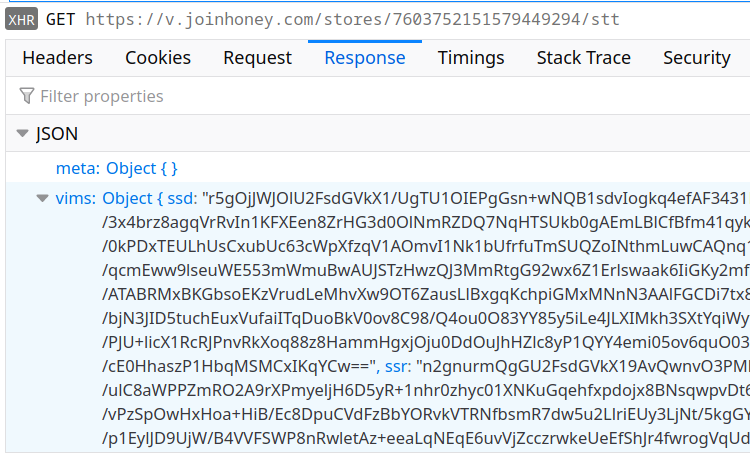
It seems that the purpose of this code is extracting user identifiers from various advertising cookies. Here is an excerpt:
var cs = {
CONTID: {
name: 'CONTID',
url: 'https://www.cj.com',
exVal: null
},
s_vi: {
name: 's_vi',
url: 'https://www.linkshare.com',
exVal: null
},
_ga: {
name: '_ga',
url: 'https://www.rakutenadvertising.com',
exVal: null
},
...
};
The extension conveniently grants this code access to all cookies on any domains. This is only the case on Chrome however, on Firefox the extension doesn’t request access to cookies. That’s most likely to address concerns that Mozilla Add-ons reviewers had.
The script also has access to jQuery. With the relaxed CSP protection of the Chrome version, this allows it to load any script from paypal.com and some other domains at will. These scripts will be able to do anything that the extension can do: read or change website cookies, track the user’s browsing in arbitrary ways, inject code into websites or even modify server responses.
On Firefox the fallout is more limited. So far I could only think of one rather exotic possibility: add a frame to the extension’s background page. This would allow loading an arbitrary web page that would stay around for the duration of the browsing session while being invisible. This attack could be used for cryptojacking for example.
About that privacy commitment…
The Honey Privacy and Security policy states:
We will be transparent with what data we collect and how we use it to save you time and money, and you can decide if you’re good with that.
This sounds pretty good. But if I still have you here, I want to take a brief look at what this means in practice.
As the privacy policy explains, Honey collects information on availability and prices of items with your help. Opening a single Amazon product page results in numerous requests like the following:
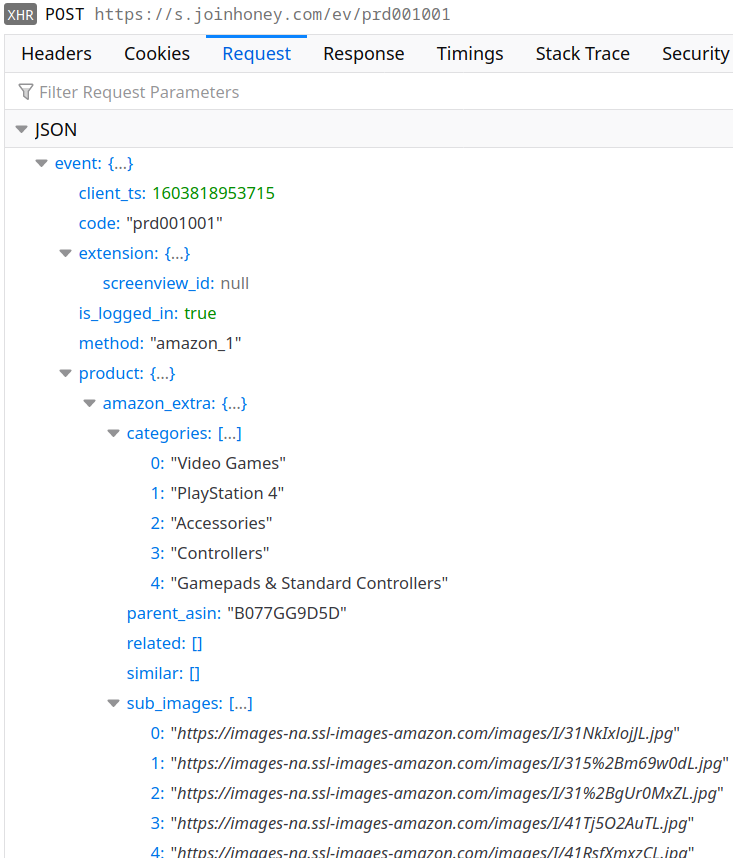
The code responsible for the data sent here is only partly contained in the extension, much of it is loaded from the server:
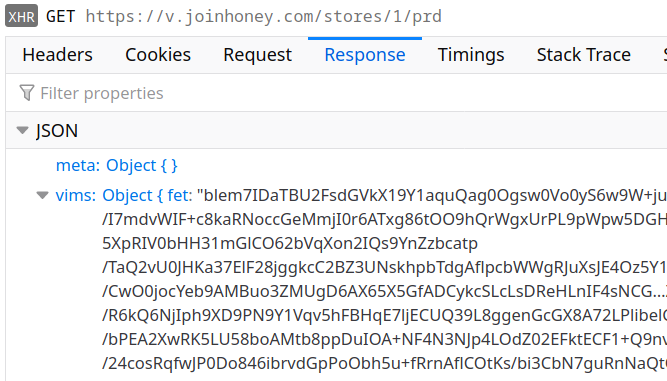
Yes, this is yet another block of obfuscated VIM code. That’s definitely an unusual way to ensure transparency…
On the bright side, this particular part of Honey functionality can be disabled. That is, if you find the “off” switch. Rather counter-intuitively, this setting is part of your account settings on the Honey website:
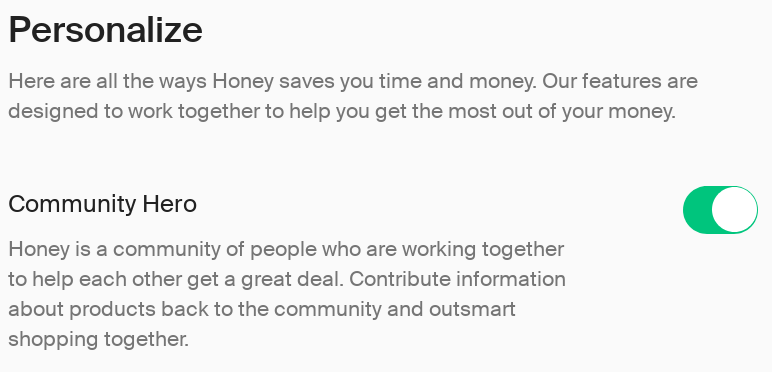
Don’t know about you, but after reading this description I would be no wiser. And if you don’t have a Honey account, it seems that there is no way for you to disable this. Either way, from what I can tell this setting won’t affect other tracking like pns_siteSelSubId1 functionality outlined above.
On a side note, I couldn’t fail to notice one more interesting feature not mentioned in the privacy policy. Honey tracks ad blocker usage, and it will even re-run certain tracking requests from the extension if blocked by an ad blocker. So much for your privacy choices.
Why you should care
In the end, I found that the Honey browser extension gives its server very far reaching privileges, but I did not find any evidence of these privileges being misused. So is it all fine and nothing to worry about? Unfortunately, it’s not that easy.
While the browser extension’s codebase is massive and I certainly didn’t see all of it, it’s possible to make definitive statements about the extension’s behavior. Unfortunately, the same isn’t true for a web server that one can only observe from outside. The fact that I only saw non-malicious responses doesn’t mean that it will stay the same way in future or that other people will make the same experience.
In fact, if the server were to invade users’ privacy or do something outright malicious, it would likely try to avoid detection. One common way is to only do it for accounts that accumulated a certain amount of history. As security researchers like me usually use fairly new accounts, they won’t notice anything. Also, the server might decide to limit such functionality to countries where litigation is less likely. So somebody like me living in Europe with its strict privacy laws won’t see anything, whereas US citizens would have all of their data extracted.
But let’s say that we really trust Honey Science LLC given its great track record. We even trust PayPal who happened to acquire Honey this year. Maybe they really only want to do the right thing, by any means possible. Even then there are still at least two scenarios for you to worry about.
The Honey server infrastructure makes an extremely lucrative target for hackers. Whoever manages to gain control of it will gain control of the browsing experience for all Honey users. They will be able to extract valuable data like credit card numbers, impersonate users (e.g. to commit ad fraud), take over users’ accounts (e.g. to demand ransom) and more. Now think again how much you trust Honey to keep hackers out.
But even if Honey had perfect security, they are also a US-based company. And that means that at any time a three letter agency can ask them for access, and they will have to grant it. That agency might be interested in a particular user, and Honey provides the perfect infrastructure for a targeted attack. Or the agency might want data from all users, something that they are also known to do occasionally. Honey can deliver that as well.
And that’s the reason why Mozilla’s Add-on Policies list the following requirement:
Add-ons must be self-contained and not load remote code for execution
So it’s very surprising that the Honey browser extension in its current form is not merely allowed on Mozilla Add-ons but also marked as “Verified.” I wonder what kind of review process this extension got that none of the remote code execution mechanisms have been detected.
Edit (2020-10-28): As Hubert Figui`ere pointed out, extensions acquire this “Verified” badge by paying for the review. All the more interesting to learn what kind of review has been paid here.
While Chrome Web Store is more relaxed on this front, their Developer Program Policies also list the following requirement:
Developers must not obfuscate code or conceal functionality of their extension. This also applies to any external code or resource fetched by the extension package.
I’d say that the VIM mechanism clearly violates that requirement as well. As I’m still to discover a working mechanism to report violations of Chrome’s Developer Program Policies, it is to be seen whether this will have any consequences.
https://palant.info/2020/10/28/what-would-you-risk-for-free-honey/
|
|
Patrick Cloke: django-render-block 0.8 (and 0.8.1) released! |
A couple of weeks ago I released version 0.8 of django-render-block, this was followed up with a 0.8.1 to fix a regression.
django-render-block is a small library that allows you render a specific block from a Django (or Jinja) template, this is frequently used for emails when …
https://patrick.cloke.us/posts/2020/10/27/django-render-block-0.8-released/
|
|
The Talospace Project: Firefox 82 on POWER goes PGO |
But let's not bury the lede here: after several days of screaming, ranting and scaring the cat with various failures, this blog post is finally being typed in a fully profile-guided and link-time optimized Firefox 82 tuned for POWER9 little-endian. Although it multiplies compile time by nearly a factor of 3 and the build process intermittently can consume a terrifying amount of memory, the PGO-LTO build is roughly 25% faster than the LTO-only build, which was already 4% faster than the "baseline" -O3 -mcpu=power9 build. That's worth an 84-minute coffee break! (-j24 on a dual-8 Talos II [64 threads], 64GB RAM.)
The problem with PGO and gcc (at least gcc 10, anyway) is that all the .gcda files end up in the same directory as the built objects in an instrumented build. The build system, which is now heavily clang-centric (despite the docs, gcc is clearly Tier 2, since this and other things don't work), does not know how to handle or transfer the resulting profile data and bombs after running the test load. We don't build with clang because in previous attempts it never managed to fully build the browser on ppc64le and I'm sceptical of its code quality on this platform anyway, but since I wanted to verify against a presumably working configuration I did try a clang build first to see if anything had changed. It breaks fairly early now, interestingly while compiling a Rust component:
4:33.00 error: /home/censored/src/mozilla-release/obj-powerpc64le-unknown-linux-gnu/release/deps/libproc_macro_hack-b7d125d9ae0afae7.so: undefined symbol: __muloti4
4:33.00 --> /home/censored/src/mozilla-release/third_party/rust/phf_macros/src/lib.rs:227:5
4:33.00 227 | #[::proc_macro_hack::proc_macro_hack]
4:33.00 | ^^^^^^^^^^^^^^^
4:33.00 error: aborting due to previous error
4:33.00 error: could not compile `phf_macros`.
So there's that. I'm not very proficient in Rust so I didn't do much more diagnosis at this point. Back to the hippo gcc.
What's needed is to hack the build system to copy the .gcda files generated during profiling out of instrumented/ into the regular build tree for the actual (second) build phase, which is essentially the solution proposed in bug 1601903 except without any explanation as to how you actually do it. The PGO driver is fortunately in a standalone Python script, so I decided to simply hijack that. At the end is code to coalesce the .profraw files from a successful instrumented clang build, which shouldn't be running anyway if the compiler is gcc, so I threw in a couple lines to terminate instead after it runs this shell script:
#!/bin/csh -f
set where=/tmp/mozgcda.tar
# all on one line yo
cd /home/censored/src/mozilla-release/obj-powerpc64le-unknown-linux-gnu/instrumented || exit
tar cvf $where `find . -name '*.gcda' -print`
cd ..
tar xvf $where
rm -f $where
This repopulates the .gcda files in the right place before we rebuild with the profile data, but because of this subterfuge, gcc thinks the generated profile is not consistent with the source and spams an incredible amount of complaint messages ... which made it difficult to spot the internal compiler error that the profile-guided rebuild triggered. This required another rebuild with some tweaks to turn that off and some other irrelevant warnings (I'll probably upstream at least one of these changes) so I could determine where the ICE was in the scrollback. Fortunately, it was in a test binary, so I just commented it out in the moz.build and it finally stuck. And so far, it's working impressively well. This may well be the fastest the browser can get while still lacking a JIT.
After all that, it's almost an anticlimax to mention that --disable-release is no longer needed in the build configs. You can put it in the Debug configuration if you want, but I now use --enable-release in optimized builds and it seems to work fine.
If you want to try compiling a PGO-LTO build yourself, here is a gist with the changes I made (they are all trivial). Save the shell script above as gccpgostub.csh in ~/src/mozilla-release and/or adjust paths as necessary, and make sure it is chmodded +x. Yes, there is no doubt a more elegant way to do this in Python itself but I hate Python and I was just trying to get it to work. Note that PGO builds can be exceptionally toolchain-dependent (and ICEs more so); while TestUtf8 was what triggered the ICE on my system (Fedora 32, gcc 10.2.1), it is entirely possible it will halt somewhere else in yours, and the PGO command line options may not work the same in earlier versions of the compiler.
Without further ado, the current .mozconfigs, starting with Optimized. Add ac_add_options MOZ_PGO=1 to enable PGO once you have patched your tree and deposited the script.
export CC=/usr/bin/gcc
export CXX=/usr/bin/g++
mk_add_options MOZ_MAKE_FLAGS="-j24"
ac_add_options --enable-application=browser
ac_add_options --enable-optimize="-O3 -mcpu=power9"
ac_add_options --enable-release
ac_add_options --enable-linker=bfd
ac_add_options --enable-lto=full
# this is implied by enable-release but left in to be explicit
export RUSTC_OPT_LEVEL=2
Debug
export CC=/usr/bin/gcc
export CXX=/usr/bin/g++
mk_add_options MOZ_MAKE_FLAGS="-j24"
ac_add_options --enable-application=browser
ac_add_options --enable-optimize="-Og -mcpu=power9"
ac_add_options --enable-debug
ac_add_options --enable-linker=bfd
export RUSTC_OPT_LEVEL=0
https://www.talospace.com/2020/10/firefox-82-on-power-goes-pgo.html
|
|
David Teller: yoric.steps.next() |
The web is getting darker. It is being weaponized by trolls, bullies and bad actors and, as we’ve witnessed, this can have extremely grave consequences for individuals, groups, sometimes entire countries. So far, most of the counter-measures proposed by either governments or private actors are even scarier.
The creators of the Matrix protocol have recently published the most promising plan I have seen. One that I believe stands a chance of making real headway in this fight, while respecting openness, decentralization, open-source and privacy.
I have been offered the opportunity to work on this plan. For this reason, after 9 years as an employee at Mozilla, I’ll be moving to Element, where I’ll try and contribute to making the web a better place. My last day at Mozilla will be October 30th.
|
|
Daniel Stenberg: Working open source |
I work full time on open source and this is how.
Background
I started learning how to program in my teens, well over thirty years ago and I’ve worked as a software engineer and developer since the early 1990s. My first employment as a developer was in 1993. I’ve since worked for and with lots of companies and I’ve worked on a huge amount of (proprietary) software products and devices over many years. Meaning: I certainly didn’t start my life open source. I had to earn it.
When I was 20 years old I did my (then mandatory) military service in Sweden. After having endured that, I applied to the university while at the same time I was offered a job at IBM. I hesitated, but took the job. I figured I could always go to university later – but life took other turns and I never did. I didn’t do a single day of university. I haven’t regretted it.

I learned to code in the mid 80s on a Commodore 64 and software development has been one of my primary hobbies ever since. One thing it taught me well, that I still carry with me, is to spend a few hours per day in front of my home computer.
And then I shipped curl
In the spring of 1998 I renamed my little pet project of the time again and I released the first ever curl release. I have told this story many times, but since then I have spent two hours or so of my spare time on that project – every day for over twenty years. While still working as a software engineer by day.

Over time, curl gradually grew popular and attracted more users. There was no sudden moment in time where I struck gold and everything took off. It was just slowly gaining ground while me and my fellow project members kept improving and polishing curl. At some point in time I happened to notice that curl and libcurl would appear in more and more acknowledgements and in open source license collections in products and devices.
It was still just a spare time project.
Proprietary Software for years
I’d like to emphasize that I worked as a contract and consultant developer for many years (over 20!), primarily on proprietary software and custom solutions, before I managed to land myself a position where I could primarily write open source as part of my job.
Mozilla
In 2014 I joined Mozilla and got the opportunity to work on the open source project Firefox for a living – and doing it entirely from my home. This was the first time in my career I actually spent most of my days on code that was made public and available to the world. They even allowed me to spend a part of my work hours on curl, even if that didn’t really help them and curl was not a fundamental part of any Mozilla work or products. It was still great.
I landed that job for Mozilla a lot thanks to my many years and long experience with portable network coding and running a successful open source project at this level.
My work setup with Mozilla made it possible for me to spend even more time on curl, apart from the (still going) two daily spare time hours. Nobody at Mozilla cared much about (my work with) curl and no one there even asked me about it. I worked on Firefox for a living.
For anyone wanting to do open source as part of their work, getting a job at a company that already does a lot of open source is probably the best path forward. Even if that might not be easy either, and it might also mean that you would have to accept working on some open source projects that you might not yourself be completely sold on.
In late 2018 I quit Mozilla, in part because I wanted to try to work with curl “for real” (and part other reasons that I’ll leave out here). curl was then already over twenty years old and was used more than ever before.
wolfSSL
I now work for wolfSSL. We sell curl support and related services to companies. Companies pay wolfSSL, wolfSSL pays me a salary and I get food on the table. This works as long as we can convince enough companies that this is a good idea.
The vast majority of curl users out there of course don’t pay anything and will never pay anything. We just need a small number of companies to do it – and it seems to be working. We help customers use curl better, we make curl better for them and we make them ship better products this way. It’s a win win. And I can work on open source all day long thanks to this.
My open source life-style
A normal day in the work week, I get up before 7 in the morning and I have breakfast with my family members: my wife and my two kids. Then I grab my first cup of coffee for the day and take the thirteen steps up the stairs to my “office”.
I sit down in front of my main development (Linux) machine with two 27'' screens and get to work.

What work and in what order?
I lead the curl project. It means many questions and decisions fall down to me to have an opinion about or say on, and it’s a priority for me to make sure that I unblock such situations as soon as possible so that developers wanting to do things with curl can continue doing that.
Thus, I read and respond to email about curl all hours I’m awake and have network access. Of course incoming messages actually rarely require immediate responses and then I can queue them up and instead do them later. I also try to read and assess all new incoming curl issues as soon as possible to see if there’s something urgent I should deal with immediately, or otherwise figure out how to deal with them going forward.
I usually have a set of bugs or features to work on so when there’s no alarming email or GitHub issue left, I context-switch over to the curl source code tree and the particular branch in which I work on right now. I typically have 20-30 different branches of development of various stages and maturity going on. If I get stuck on something, or if I create a pull-request for one of them that needs time to get all the CI jobs done, I switch over to one of the others.
Customers and their needs of course have priority when I decide what to work on. The exception would perhaps be security vulnerabilities or other really serious bugs being reported, but thankfully they are rare. But after that, I go by ear and work on what I think is fun and what I think users might appreciate.
If I want to go forward with something, for my own sake or for a customer’s, and that entails touching or improving other software in other projects, then I don’t shy away from submitting pull requests for them – or at least filing an issue.
Spare time open source
Yes, I still spend my spare time hours on open source, mostly curl. This means I often end up spending 50-55 hours per week on curl and curl related activities. But I don’t count or measure work hours and I rarely have to report any to anyone. This is a work of love.
Lots of people will say that they don’t have time because of life, family, kids etc. I have of course been very fortunate over the years to have had the opportunity and ability to spend all this time on what I want to do, but let’s not forget that people in general spend lots of time on their hobbies; on watching TV, on playing computer games and on socializing with friends and why not: to sleep. If you cut down on all of those things (yes, including the sleeping) there could very well be opportunities. It’s often a question of priorities. I’ve made spare time development a priority in my life.
curl support?
Any company that uses curl or libcurl – and they are plenty – could benefit from buying support from us instead of wasting their own time and resources. We at wolfSSL are probably much better at curl already and we can find and fix the issues much faster, which ends up cheaper and better long-term.
Credits
The top photo is taken by Anja Stenberg, my wife. It’s me in a local forest, summer 2020.
|
|
Mike Hoye: Navigational Instruments |
A decade ago I got to sit in on a talk by one of the designers of Microsoft Office who’d worked on the transition to the new Ribbon user interface. There was a lot to learn there, but the most interesting thing was when he explained the core rationale for the redesign: of the top ten new feature requests for Office, every year, six to eight of them were already features built into the product, and had been for at least one previous version. They’d already built all this stuff people kept saying they wanted, and nobody could find it to use it.
It comes up periodically at my job that we have the same problem; there are so many useful features in Firefox that approximately nobody knows about, even people who’ve been using the browser every day and soaking in the codebase for years. People who work here still find themselves saying “wait, you can do that?” when a colleague shows them some novel feature or way to get around the browser that hasn’t seen a lot of daylight.
In the hopes of putting this particular peeve to bed, I did a casual survey the other day of people’s favorite examples of underknown or underappreciated features in the product, and I’ve collected a bunch of them here. These aren’t Add-ons, as great as they are; this is what you get from Firefox out of the proverbial box. I’m going to say “Alt” and “Ctrl” a lot here, because I live in PC land, but if you’re on a Mac those are “Option” and “Command” respectively.
Starting at the top, one of the biggest differences between Firefox and basically everything else out there is right there at the top of the window, the address bar that we call the Quantumbar.
Most of the chromium-client-state browsers seem to be working hard to nerf out the address bar, and URLs in general. It’s my own paranoia, maybe, but I suspect the ultimate goal here is to make it easier to hide how much of that sweet, sweet behavioral data this will help companies siphon up unsupervised. Hoarding the right to look over your shoulder forever seems to be the name of the game in that space, and I’ve got a set of feelings about that you might be able to infer from this paragraph. It’s true that there’s a lot of implementation detail being exposed there, and it’s true that most people might not care so why show it, but being able to see into the guts of a process so you can understand and trust it is just about the whole point of the open-source exercise. Shoving that already-tiny porthole all the way back into the bowels of the raw codebase – particularly when the people doing the shoving have entire identities, careers and employers none of which would exist at all if they hadn’t leveraged the privileges of open software for themselves – is galling to watch, very obviously a selfish, bad-faith exercise. It reduces clicking a mouse around the Web to little more than clicking a TV remote, what Douglas Adams use to call the “point and grunt interface”.
Fortunately the spirit of the command line, in all its esoteric and hidden power, lives on in a few places in Firefox. Most notably in a rich set of Quantumbar shortcuts you can use to get around your browser state and history:
- Start typing your search with ^ to show only matches in your browsing history.
- * to show only matches in your bookmarks.
- + to show only matches in bookmarks you’ve tagged.
- % to show only matches in your currently open tabs.
- # to show only matches where every search term is part of the title or part of a tag.
- $ to show only matches where every search term is part of the web address (URL). The text “https://” or “http://” in the URL is ignored but not “file:///”.
- Add ? to show only search suggestions.
- Hitting Ctrl-enter in the URL bar works like autocomplete;”mozilla” go straight to www.mozilla.com, for example. Shift-enter will open a URL in a new tab.
Speaking of the Quantumbar, you can customize it by right-clicking any of the options in the three-dot “Page Options” pulldown menu, and adding them to the address bar. The screenshot tool is pretty great, but one of my personal favorites in that pile is Reader Mode. Did you know there’s text-to-speech built into Reader Mode? It surprised me, too. Click those headphones, see how it goes.
It’s sort of Quantumbar-adjacent, but once you’ve been using it for a few hours the Search Keyword feature is one of those things you just don’t go back to not having. If you right-click or a search field on just about any site, “Add a Keyword for this Search” is one of the options. give it a simple term or letter, then “
There are a lot of other small navigation tricks that come in surprisingly handy:
- Holding down Alt while selecting text allows you to select text within a link without triggering the link
- Shift-right-click will show Firefox’s context menu even on sites that override it. This is great for Picture-In-Picture most video sites, and getting your expected context menu back from GDocs. (PiP is another feature I’m fond of.)
- Clicking and dragging down on the forward and back buttons will show a list of previous or next pages this tab has visited.
- You can use Ctrl-click and middle-mouseclick on most toolbar buttons to open whatever they point at in a new tab; Ctrl-reload duplicates your current tab. You can use this trick to pop stuff out of the middle of your back and forward history stack into new tabs.
- You can do this trick with the “view image” option in the right-click menu, too – Ctrl-clicking that menu item will open that image in its own new tab.
- New Tab then Undo – Ctrl-T then Ctrl-Z – will populate the address bar with the URL of the previously focused tab, and it’s useful to duplicate the current tab from the keyboard.
- You can right click an iframe and use the This Frame option to open the iframe in a tab of its own, then access the URL and other things.
- Ctrl+Shift+N will reopen the most recently closed window, Ctrl+Shift+T the most recently closed tab. The tabs are a history stack, so you can keep re-opening them.
- Knowing you can use Ctrl-M to mute a tab is invaluable.
If you’re a tab-hoarder like me, there’s a lot here to make your life better; Ctrl-# for some N 1 to 8 will switch you to the Nth tab, and Ctrl-9 takes you to the rightmost tab (in left-to-right language layouts, it’s mirrored in RTL). You might want to look over the whole list of keyboard shortcuts, if that’s your thing. There are a lot of them. But probably the most underappreciated is that you can select multiple tabs by using Shift-click, so you can work on the as a group. Ctrl-click will also let you select non-adjacent tabs, as you might expect, and once you’ve selected a few you can:
- Move them as a group, left, right, new window, into Container tabs, you name it.
- Pin them (Pinned tabs are another fantastic feature, and the combination of pinned tabs and ctrl-# is very nice.)
- Mute a bunch of tabs at once.
- If you’ve got Sync set up – and if you’ve got more than one device, seriously, make your life better and set up sync! – you can right-click and send them all to a different device. If you’ve got Firefox on your phone, “send these ten tabs to my phone” is one click. That action is privacy-respecting, too – nobody can see what you’re sending over, not even Mozilla.
I suspect it’s also not widely appreciated that you can customize Firefox in some depth, another option not widely available in other browsers. Click that three-bar menu in the upper right, click customize; there’s a lot there.
- You get light, dark and Alpenglow themes stock, and you can find a bunch more on AMO to suit your taste.
- There’s a few buttons in there for features you didn’t know Firefox had, and you can put them wherever
- Density is a nice tweak, and removing the title bar is great for squeezing more real estate out of smaller laptop screens.
- Overflow menu is a great place to put lightly used extensions or buttons
- There’s a few Easter eggs in there, too, I’m told?
You can also play some games with named profiles that a lot of people doing web development find useful as well. By modifyingyour desktop shortcuts to add “-P [profile name]” –no-remote” after the firefox.exe bit, you can have “personal Firefox” and “work Firefox” running independently and fully separately from each other. That’s getting a bit esoteric, but if you do a lot of webdev or testing you might find it helpful.
So, there you go, I hope it’s helpful.
I’ll keep that casual survey running for a while, but if your personal favorite pet feature isn’t in there, feel free to email me. I know there are more.
http://exple.tive.org/blarg/2020/10/25/navigational-instruments/
|
|
Daniel Stenberg: A server transition |
The main physical server (we call it giant) we’ve been using at Haxx for a very long time to host sites and services for 20+ domains and even more mailing lists. The machine – a physical one – has been colocated in an ISP server room for over a decade and has served us very well. It has started to show its age.
Some of the more known sites and services it hosts are perhaps curl, c-ares, libssh2 and this blog (my entire daniel.haxx.se site). Some of these services are however primarily accessed via fronting CDN servers.
giant is a physical Dell PowerEdge 1850 server from 2005, which has undergone upgrades of CPU, disks and memory through the years.
giant featured an Intel X3440 Xeon CPU at 2.53GHz with 8GB of ram when decommissioned.

New host
The new host is of course entirely virtual and we’ve finally taken the step into the modern world of VPSes. The new machine is hosted by the same provider as before but as an entirely new instance.
We’ve upgraded the OS, all packages and we’ve remodeled how we run the web services and all our jobs and services from before have been moved into this new fresh server in an attempt to leave some of the worst legacies behind.
The former server will not be used anymore and will be powered down and sent for recycling.
Glitches in this new world
We’ve tried really hard to make this transition transparent and ideally not many users will notice anything or have a reason to bother about this, but of course we also realize that we probably have not managed this to 100% perfection. If you detect something on any of the services we run that used to work or exist but isn’t anymore, do let us know so that become aware of it and can work on a fix!
This site (daniel.haxx.se) already moved weeks ago and nobody noticed. The curl site changed on October 23 and are much more likely to get glitches because of all the many more scripts and automatic things setup for it. Both sites are served via Fastly so ordinary users will not detect or spot that there’s a new host in the back end.
|
|
Mozilla Localization (L10N): L10n Report: October 2020 Edition |
New content and projects
What’s new or coming up in Firefox desktop
Upcoming deadlines:
- Firefox 83 is currently in beta and will be released on November 17. The deadline to update localization is on November 8 (see the previous l10n report to understand why it moved closer to the release date).
- There might be changes to the release schedule in December. If that happens, we’ll make sure to cover them in the upcoming report.
The number of new strings remains pretty low, but there was a change that landed without new string IDs: English switched from a hyphen (-) to an em dash (–) as separator for window titles. Since this is a choice that belongs to each locale, and the current translation might be already correct, we decided to not invalidate all existing translations and notify localizers instead.
You can see the details of the strings that changed in this changeset. The full list of IDs, in case you want to search for them in Pontoon:
- browser-main-window
- browser-main-window-mac
- page-info-page
- page-info-frame
- webrtc-indicator-title
- tabs.containers.tooltip
- webrtcIndicator.windowtitle
- timeline.cssanimation.nameLabel
- timeline.csstransition.nameLabel
- timeline.scriptanimation.nameLabel
- toolbox.titleTemplate1
- toolbox.titleTemplate2
- TitleWithStatus
- profileTooltip
Alternatively, you can search for “ – “ in Pontoon, but you’ll have to skim through a lot of results, since Pontoon searches also in comments.
What’s new or coming up in mobile
Firefox for iOS v29, as well as iOS v14, both recently shipped – bringing with them the possibility to make Firefox your default browser for the first time ever!
v29 also introduced a Firefox homescreen widget, and more widgets will likely come soon. Congratulations to all for helping localize these awesome new features!
v30 strings have just recently been exposed on Pontoon, and the deadline for l10n strings completion is November 4th. Screenshots will be updated for testing very soon.
Firefox for Android (“Fenix”) is currently open for localizing v83 strings. The next couple of weeks should be used for completing your current pending strings, as well as testing your work for the release. Take a look at our updated docs here!
What’s new or coming up in web projects
Mozilla.org
Recently, the monthly WNP pages that went out with the Firefox releases contained content promoting features that were not available for global markets or campaign messages that targeted select few markets. In these situations, for all the other locales, the page was always redirected to the evergreen WNP page. As a result, please make it a high priority if your locale has not completed the page.
More pages were added and migrated to Fluent format. For migrated content, the web team has decided not to make any edits until there is a major content update or page layout redesign. Please take the time to resolve errors first as the page may have been activated. If a placeable error is not fixed, it will be shown on production.
Common Voice & WebThings Gateway
Both projects now have a new point of contact. If you want to add a new language or have any questions with the strings, send an email directly to the person first. Follow the projects’ latest development through the channels on Discourse. The l10n-drivers will continue to provide support to both teams through the Pontoon platform.
What’s new or coming up in SuMo
Please help us localize the following articles for Firefox 82 (desktop and Android):
- What’s New in Firefox for Android
- How to grant camera access
- How to delete sync data
- How to delete Firefox Account
What’s new or coming up in Pontoon
Spring cleaning on the road to Django 3. Our new contributor Philipp started the process of upgrading Django to the latest release. In a period of 12 days, he landed 12(!) patches, ranging from library updates and replacing out-of-date libraries with native Python and Django capabilities to making our testing infrastructure more consistent and dropping unused code. Well done, Philipp! Thanks to Axel and Jotes for the reviews.
Newly published localizer facing documentation
Firefox for Android docs have been updated to reflect the recent changes introduced by our migration to the new “Fenix” browser. We invite you to take a look as there are many changes to the Firefox for Android localization workflow.
Events
Kudos to these long time Mozillians who found creative ways to spread the words promoting their languages and sharing their experience by taking the public airways.
- Wim of Frisian was interviewed by a local radio station where he shared his passion localizing Mozilla projects. He took the opportunity to promote Common Voice and call for volunteers speaking Frisian. Since the airing of the story, Frisian saw an increase with 11 hours spoken clips and an increase between 250 to 400 people donating their voices. The interview would be aired monthly.
- Quentin of Occitan made an appearance in this local news story in the south of French, talking about using Pontoon to localize Mozilla products in Occitan.
Want to showcase an event coming up that your community is participating in? Reach out to any l10n-driver and we’ll include that (see links to emails at the bottom of this report)
Friends of the Lion
- Iskandar of Indonesian community for his huge efforts completing Firefox for Android (Fenix) localization in recent months.
- Dian Ina and Andika of Indonesian community for their huge efforts completing the Thunderbird localization in recent months!
Know someone in your l10n community who’s been doing a great job and should appear here? Contact one of the l10n-drivers and we’ll make sure they get a shout-out (see list at the bottom)!
Useful Links
- #l10n-community channel on Matrix
- Dev.l10n mailing list and Dev.l10n.web mailing list – where project updates happen. If you are a localizer, then you should be following this
- Telegram (contact one of the l10n-drivers below so we will add you)
- L10n blog
Questions? Want to get involved?
- If you want to get involved, or have any question about l10n, reach out to:
- Delphine – l10n Project Manager for mobile
- Peiying (CocoMo) – l10n Project Manager for mozilla.org, marketing, and legal
- Francesco Lodolo (flod) – l10n Project Manager for desktop
- Th'eo Chevalier – l10n Project Manager for Mozilla Foundation
- Matjaz – Pontoon dev
- Jeff Beatty (gueroJeff) – l10n-drivers manager
Did you enjoy reading this report? Let us know how we can improve by reaching out to any one of the l10n-drivers listed above.
https://blog.mozilla.org/l10n/2020/10/22/l10n-report-october-2020-edition/
|
|
Hacks.Mozilla.Org: MDN Web Docs: Editorial strategy and community participation |
We’ve made a lot of progress on moving forward with MDN Web Docs in the last couple of months, and we wanted to share where we are headed in the short- to mid-term, starting with our editorial strategy and renewed efforts around community participation.
New editorial strategy
Our updated editorial strategy has two main parts: the creation of content pillars and an editorial calendar.
The MDN writers’ team has always been responsible for keeping the MDN web platform reference documentation up-to-date, including key areas such as HTML, CSS, JavaScript, and Web APIs. We are breaking these key areas up into “content pillars”, which we will work on in turn to make sure that the significant new web platform updates are documented each month.
Note: This also means that we can start publishing our Firefox developer release notes again, so you can keep abreast of what we’re supporting in each new version, as well as Mozilla Hacks posts to give you further insights into what we are up to in Firefox engineering.
We will also be creating and maintaining an editorial calendar in association with our partners on the Product Advisory Board — and the rest of the community that has input to provide — which will help us prioritize general improvements to MDN documentation going forward. For example, we’d love to create more complete documentation on important web platform-related topics such as accessibility, performance, and security.
MDN will work with domain experts to help us update these docs, as well as enlist help from you and the rest of our community — which is what we want to talk about for the rest of this post.
Community call for participation
There are many day-to-day tasks that need to be done on MDN, including moderating content, answering queries on the Discourse forums, and helping to fix user-submitted content bugs. We’d love you to help us out with these tasks.
To this end, we’ve rewritten our Contributing to MDN pages so that it is simpler to find instructions on how to perform specific atomic tasks that will help burn down MDN backlogs. The main tasks we need help with at the moment are:
- Fixing MDN content bugs — Our sprints repo is where people submit issues to report problems found with MDN docs. We get a lot of these, and any help you can give in fixing issues would be much appreciated.
- Help beginners to learn on MDN — Our Learn web development pages get over a million views per month, and have active forums where people go to ask for general help, or request that their assessments be marked. We’d love some help with answering posts, and growing our learning community.
We hope these changes will help revitalize the MDN community into an even more welcoming, inclusive place where anyone can feel comfortable coming and getting help with documentation, or with learning new technologies or tools.
If you want to talk to us, ask questions, and find out more, join the discussion on the MDN Web Docs chat room on Matrix. We are looking forward to talking to you.
Other interesting developments
There are some other interesting projects that the MDN team is working hard on right now, and will provide deeper dives into with future blog posts. We’ll keep it brief here.
Platform evolution — MDN content moves to GitHub
For quite some time now, the MDN developer team has been planning a radical platform change, and we are ready to start sharing details of it. In short, we are updating the platform to move from a Wiki approach with the content in a MySQL database, to a JAMStack approach with the content being hosted in a Git repository (codename: Project Yari).
This will not affect end users at all, but the MDN developer team and our content contributors will see many benefits including a better contribution workflow (via Github), better ways in which we can work with our community, and a simplified, easier-to-maintain platform architecture. We will talk more about this in the next blog post!
Web DNA 2020
The 2019 Web Developer Needs Assessment (Web DNA) is a ground-breaking piece of research that has already helped to shape the future of the web platform, with input from more than 28,000 web developers’ helping to identify the top pain points with developing for the web.
The Web DNA will be run again in 2020, in partnership with Google, Microsoft, and several other stakeholders providing input into the form of the questions for this year. We launched the survey on October 12, and this year’s report is due out before the end of the year.
The post MDN Web Docs: Editorial strategy and community participation appeared first on Mozilla Hacks - the Web developer blog.
https://hacks.mozilla.org/2020/10/mdn-web-docs-editorial-strategy-and-community-participation/
|
|
Doug Belshaw: Notification literacy? |
I watched The Social Dilemma last night.
Some people have criticised the film as being light on practical responses that everyday people can make. They point out that while there are recommended steps, they come right at the end of the film while the credits are rolling.
I thought it was excellent, and that the aim of the film was awareness-raising in the general population, with the main focus on politicians and people who make the laws in western societies (particularly the USA). To me, it showed that, far from being regulated as ‘publishers’, governments should instead consider regulating companies running social networks in the same way as they regulate gambling companies.
As I’m not planning on running for political office anytime soon, I thought I’d stick to what I know (new literacies!) and think about what it means to talk about ‘notification literacy’. That particular term currently returns zero results in Google Scholar, a search engine for academic articles. If I search DuckDuckGo, one of my own posts from 2017 is in the top few results.
My conclusion to that post from three years ago:
I think we’re still in a transition period with social networks and norms around them. These, as with all digital literacies, are context-dependent, so what’s acceptable in one community may be very different to what’s acceptable in another. It’s going to be interesting to see how these design patterns evolve over time, and how people develop social norms to deal with them.
Those ‘social norms’ have been shot to pieces by companies employing machine learning to growth hack the human brain. In other words, they’ve optimised engagement with their platforms to such an extent that it bypasses human rationality.
So what can we do about it? #
In work we do with clients, We Are Open Co-op runs what we call a pre-mortem where we imagine that a project has completely failed. Then we think about the preventative measures we can take to stop the reasons for that failure, as well as the mitigating actions to make the situation less bad (if those reasons are already in play).
If we apply that approach to social media usage, let’s imagine that you’re about to join Instagram. Then, let’s add into the mix that six months from now you’re unhappy, depressed, and addicted to the platform. What can we do to prevent that? What can we do to mitigate it?
Preventative measures #
Prevention is always easier than cure. The most obvious step is not to use social networks for which we have proof of harms. But if that’s not an option, then there’s ways of using social networks other than the default. For example, it’s possible to use Instagram and Twitter with a private account which changes who may interact with you.
More importantly, though, as the title of this post suggests, is to think carefully about the notifications you want to receive from the platform. Not only can you change these in the settings of the social network itself, but the latest version of both Android and iOS operating systems allow smartphone users to further configure notifications.
Instead of starting from the default position of having all notifications turned on, you might want to start from a position of having all of the notifications turned off.
Mitigating actions #
What if, like many people, you already recognise the signs of addiction in yourself and others? What can you do to wean yourself off that dependence on social networks to fill spare moments and the gaping emotional void in your life?
The first thing you can do is to switch to the mobile web version of social networks rather than having a native app installed. Then, when you’ve logged in, and you are prompted to allow notifications do not allow them. In practice, this means that you treat a social network just like any other website.
I don’t use Facebook products, but with Twitter a useful tip is to check the option on the Settings page for receiving direct messages by email. You can then be sure you’re not missing anything really important.
Going further #
It was only by watching The Social Dilemma that I realised the preventative measures and mitigating actions I’ve been taking over the last decade. While I’ve got a powerful 5G smartphone and a smartwatch, I’ve configured them both to work for me, rather than the other way around.
One important way I’ve done this is by changing the launcher I use on Android to a much more minimalist one. The one I’m using now, Before, has been revolutionary in terms of the way that it deals with notifications. I believe in paying for the things that add value to your life, so I’m happy to be supporting the developers of that particular product.
In conclusion… #
Don’t accept the defaults! On the other side of that very engaging, colourful screen are weaponised machine learning algorithms who are not interested in you or your wellbeing. While it sounds a bit sci-fi and dystopian to say so, they’re interested in providing shareholder value to megacorps by selling your attention to advertisers who want to change your behaviour.
Put like that, why wouldn’t you want to increase your notification literacy and that of those around you?
Comments? Questions? I’m on the Fediverse, or you can email me: doug@weareopen.coop
|
|








